Experience the ultimate family fly fishing adventure!
Blue Safari Fly Fishing Seychelles invites all families to join us for a fishing adventure of a lifetime. If you book a full-board fly fishing experience, your children 17 years and under can stay for FREE and are only charged for the fly fishing package and flights. Join us between June and October 2025 and experience some of the worlds best flats fishing with your loved ones making memories for life.
Enquire Now
Saltwater Fly Fishing
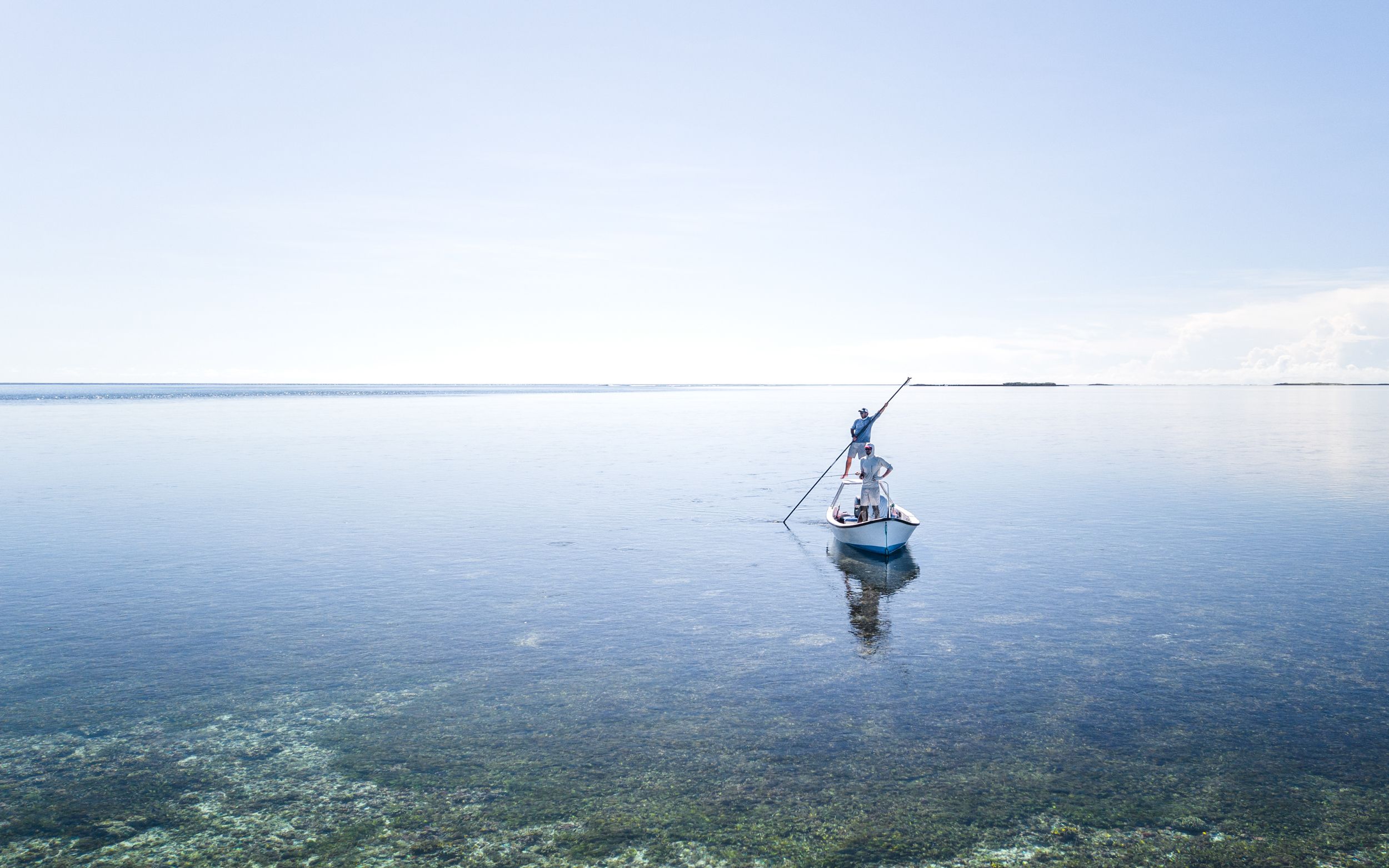
Where it all began, the History of Fly Fishing…
In the early days of angling, freshwater fly fishing couldn’t satiate the hunger for greater challenges. Adventurous spirits were drawn to the untamed depths of the ocean, where saltwater fly fishing was born. Armed with their finely crafted rods, these audacious anglers set out to conquer the vibrant realm of the sea. Casting their flies amidst crashing waves and salt-kissed air, they encountered mighty oceanic creatures – marlin with stunning blue backs, sailfish adorned with artistic patterns, and bonefish gracefully darting beneath the water’s surface.
As each cast and rise unfolded, the history of saltwater fly fishing took shape. Tackle evolved to withstand the power of the ocean, with stronger rods and resilient lines designed for these remarkable battles. Anglers from all corners of the world gathered on sun-drenched beaches and lush islands to challenge the untamed creatures of the saltwater realm. This pursuit fostered camaraderie, inspiring laughter and tales of triumph against the relentless might of the ocean’s champions.
Saltwater fly fishing has become more than a mere hobby; it has transformed into an esteemed art form. It requires a delicate balance of skill, technique, and intuition, showcasing an angler’s connection with nature. The industry has resulted in friendships blooming, souls enriched, and a tight-knit community naturally formed.
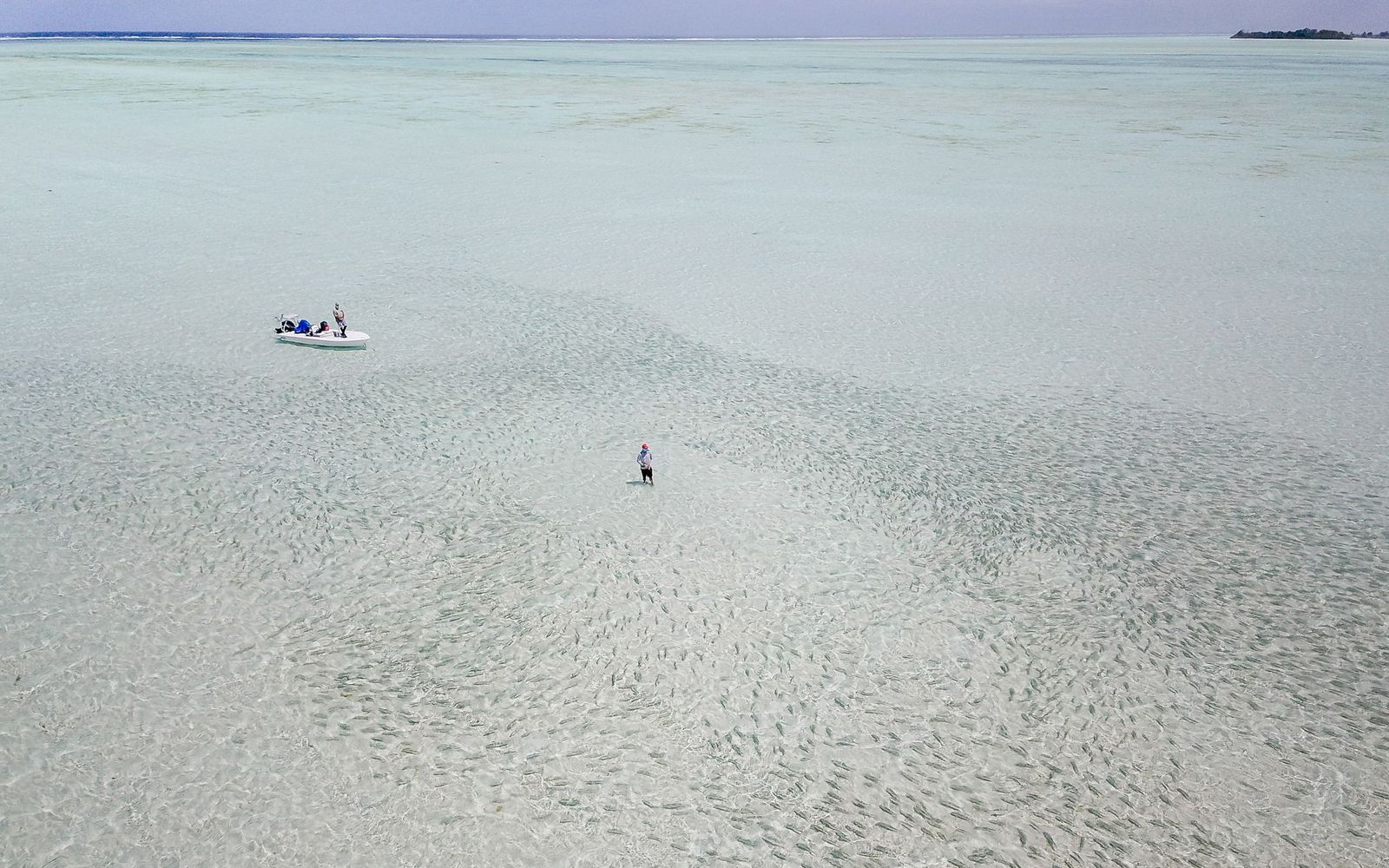
Bonefish on Alphonse Island, a staple for saltwater fly anglers
Saltwater fly fishing in the Seychelles Outer Islands
Saltwater fly fishing in the Seychelles Outer Islands offers anglers a unique and exciting opportunity to explore the diverse and abundant waters of the Indian Ocean. The Outer Islands of the Seychelles are known for their clear water, stunning scenery, and rich marine life, making them a prime destination for fly fishing enthusiasts.
Anglers can expect to target a variety of fish species, including bonefish, trevally, giant trevally, yellowfin tuna, wahoo, barracuda, snapper, grouper, dorado, triggerfish, milkfish, and many others. With the help of local guides, fly fishermen can access the best fishing spots and receive valuable tips on fly selection and presentation to maximize their chances of success.
The influence of the tides and weather is important to consider when fly fishing in the Seychelles Outer Islands, as these factors can have a significant impact on the behaviour and feeding patterns of the fish. With the right preparation and understanding of the conditions, however, fly fishers can experience some of the best saltwater fly fishing in the world in the Seychelles outer islands.
In terms of equipment, it is recommended to use a specialized saltwater fly rod, reel, and line that are designed to handle the demands of fishing in this environment. With the right gear and techniques, anglers can enjoy a truly unforgettable fly fishing experience in the Seychelles outer islands.
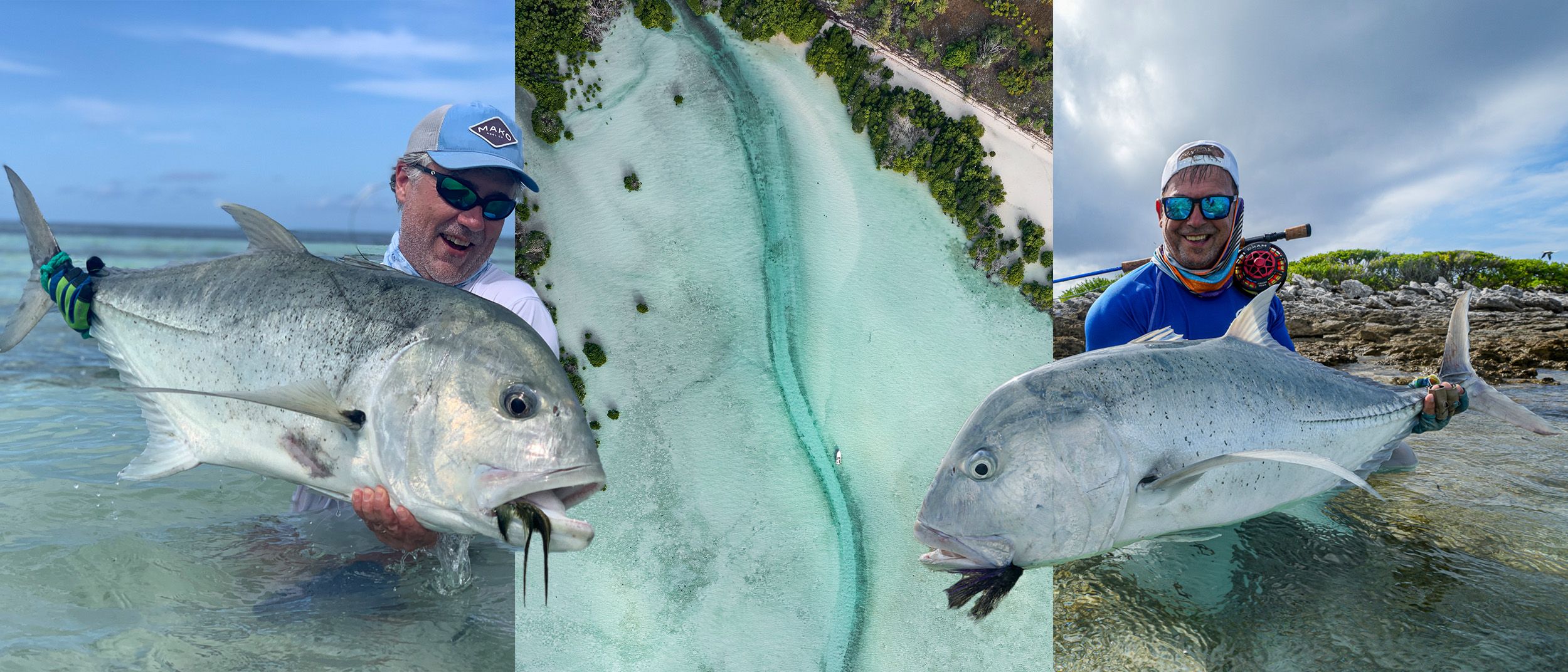 Giant Trevally at Cosmoledo Atoll, the ‘GT Capital of the World’
Giant Trevally at Cosmoledo Atoll, the ‘GT Capital of the World’
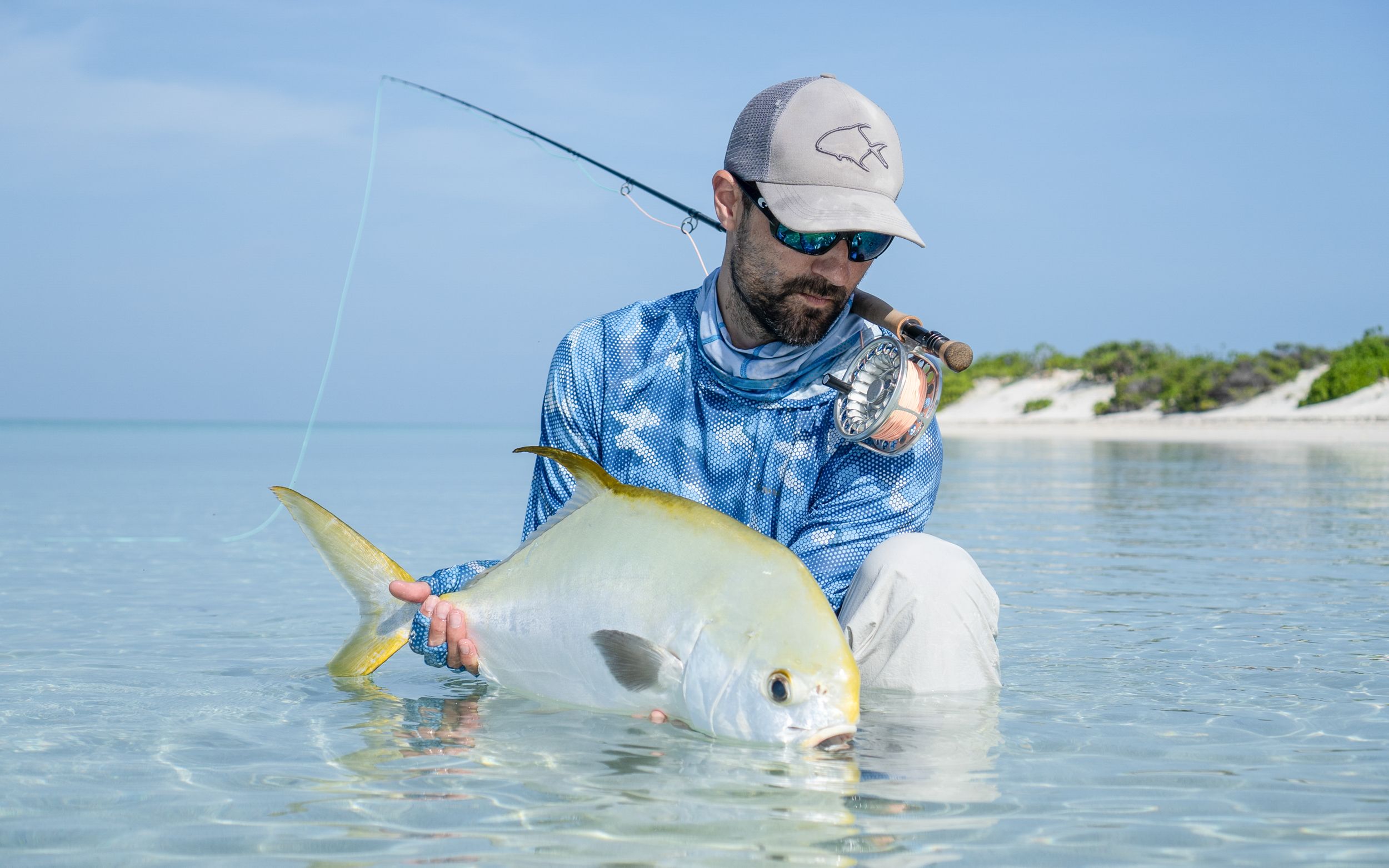
Indo-Pacific permit caught on a fly
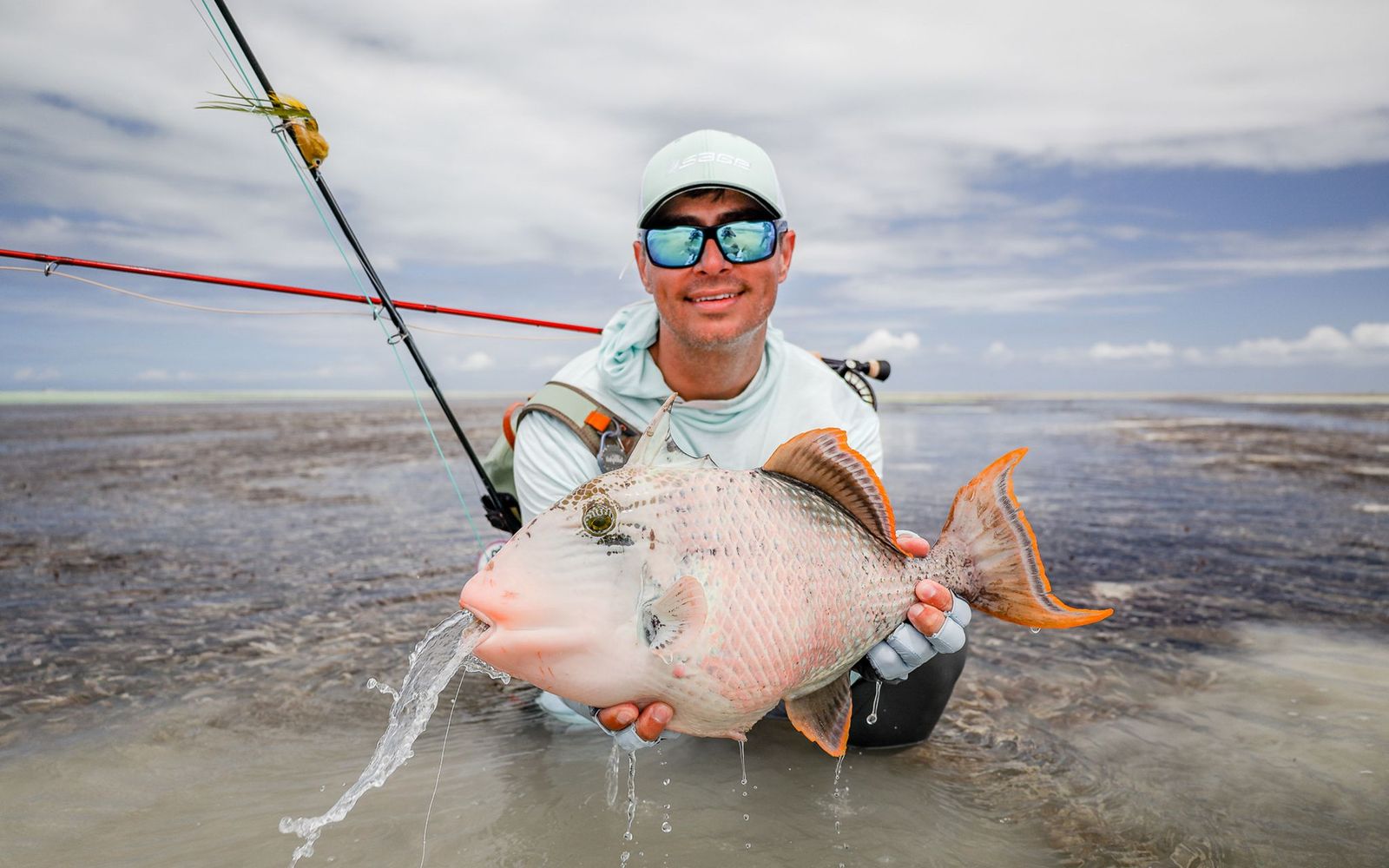
Yellowmargin triggerfish caught on a fly
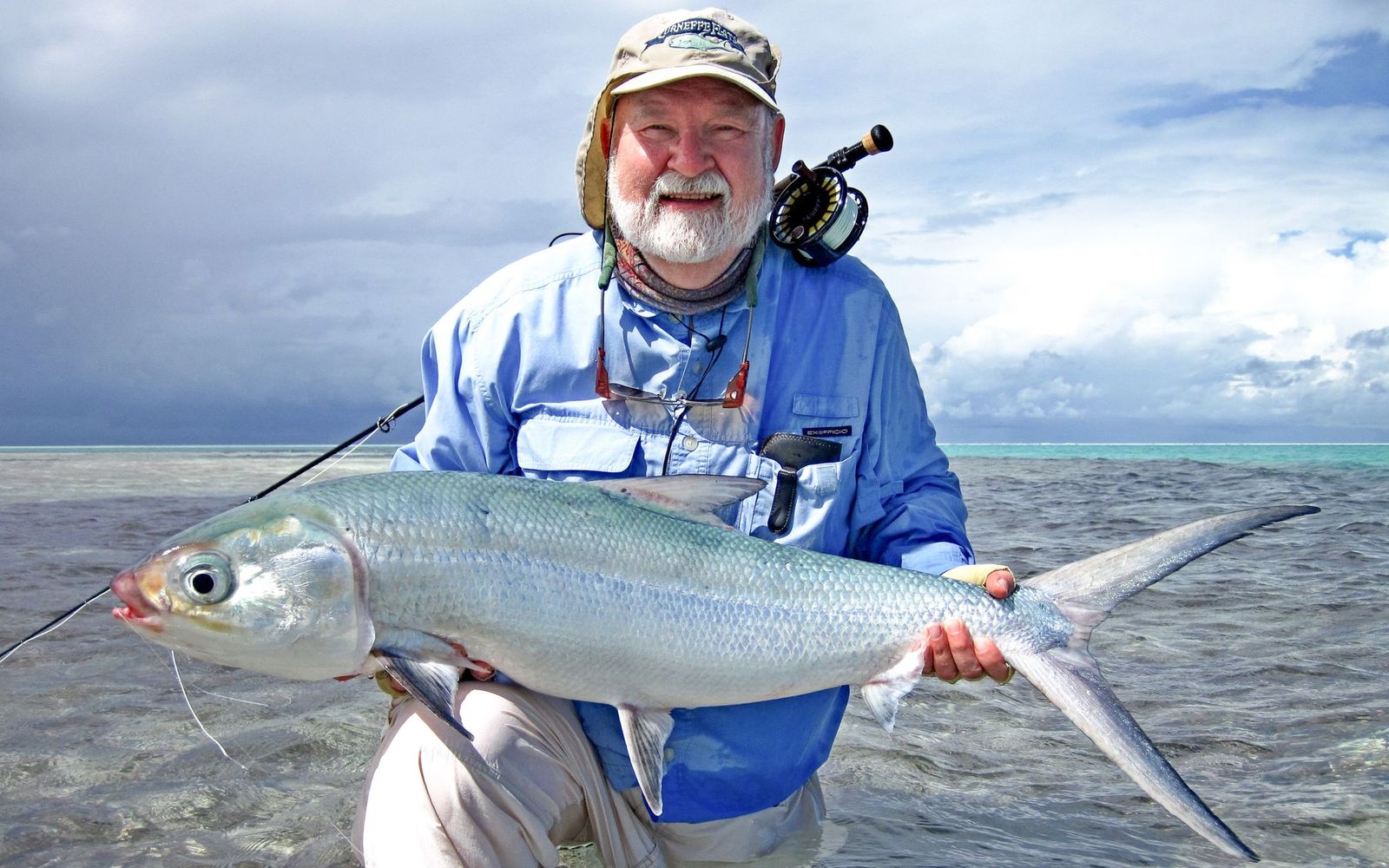 Milkfish caught on a fly
Milkfish caught on a fly
Overview of fly fishing in the ocean/islands with the Alphonse Island team
Fly fishing in the ocean with the Alphonse Island team is a truly exceptional experience for anglers. Alphonse Island is a remote and pristine location in the Seychelles outer islands that offers world-class saltwater fly fishing opportunities. The Alphonse Island team consists of experienced guides and staff who are passionate about fly fishing and committed to providing their guests with the best possible experience.
Saltwater fly fishing guides at Alphonse Fishing Co
Choosing the right fishing operator can make or break your fishing experience. You need a team that is highly experienced, highly skilled and highly informed about local conditions.
Alphonse Fishing Company™, with more years of experience on the outer islands than any other organisation, fills all three of these needs. You can rest assured that you’re at the best fishing spots, during the best times of the year, and under the watchful eyes of the world’s finest fly fishing guides and captains.
We are proud to boast the services of a highly skilled team with a wealth of knowledge, who strive to enhance the guests’ experience and contribute to ecotourism and experiential travel. As leaders in fly fishing in the Seychelles, we have an extensive understanding of the area, our guides are well-versed on the best fishing spots, tidal movements and elemental conditions. We thrive on putting guests on fish and ensuring the very best fishing adventure, be it on an annual or once-in-a-lifetime trip.
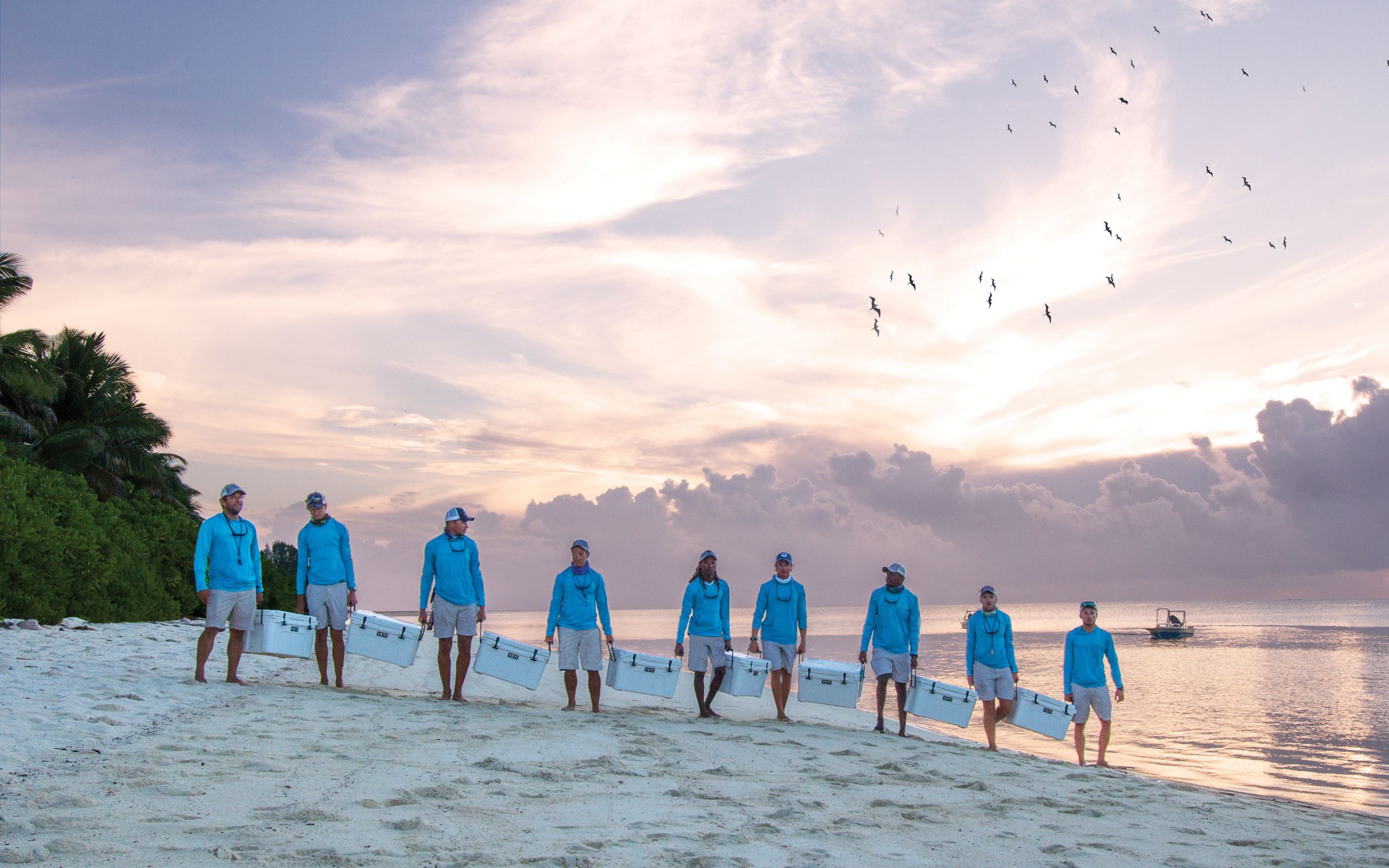 Alphonse Fishing Co guide team on Alphonse Island
Alphonse Fishing Co guide team on Alphonse Island
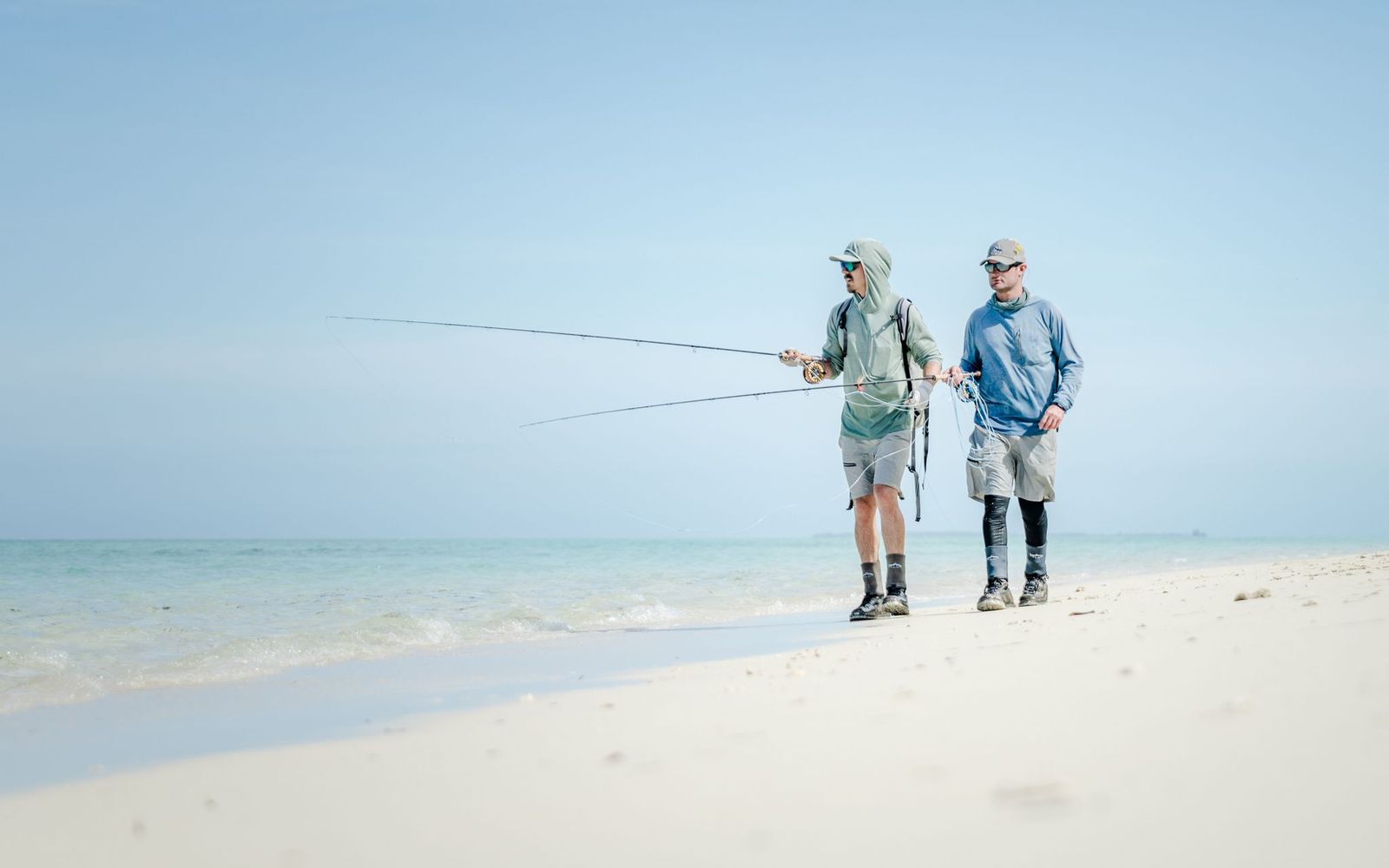
Angler guided on a surf walk
Saltwater fly fishing gear/equipment
Saltwater fly fishing typically requires specialized gear designed to handle the corrosive saltwater environment, such as saltwater-resistant rods, reels, and lines.
Choosing the perfect saltwater fly fishing rods
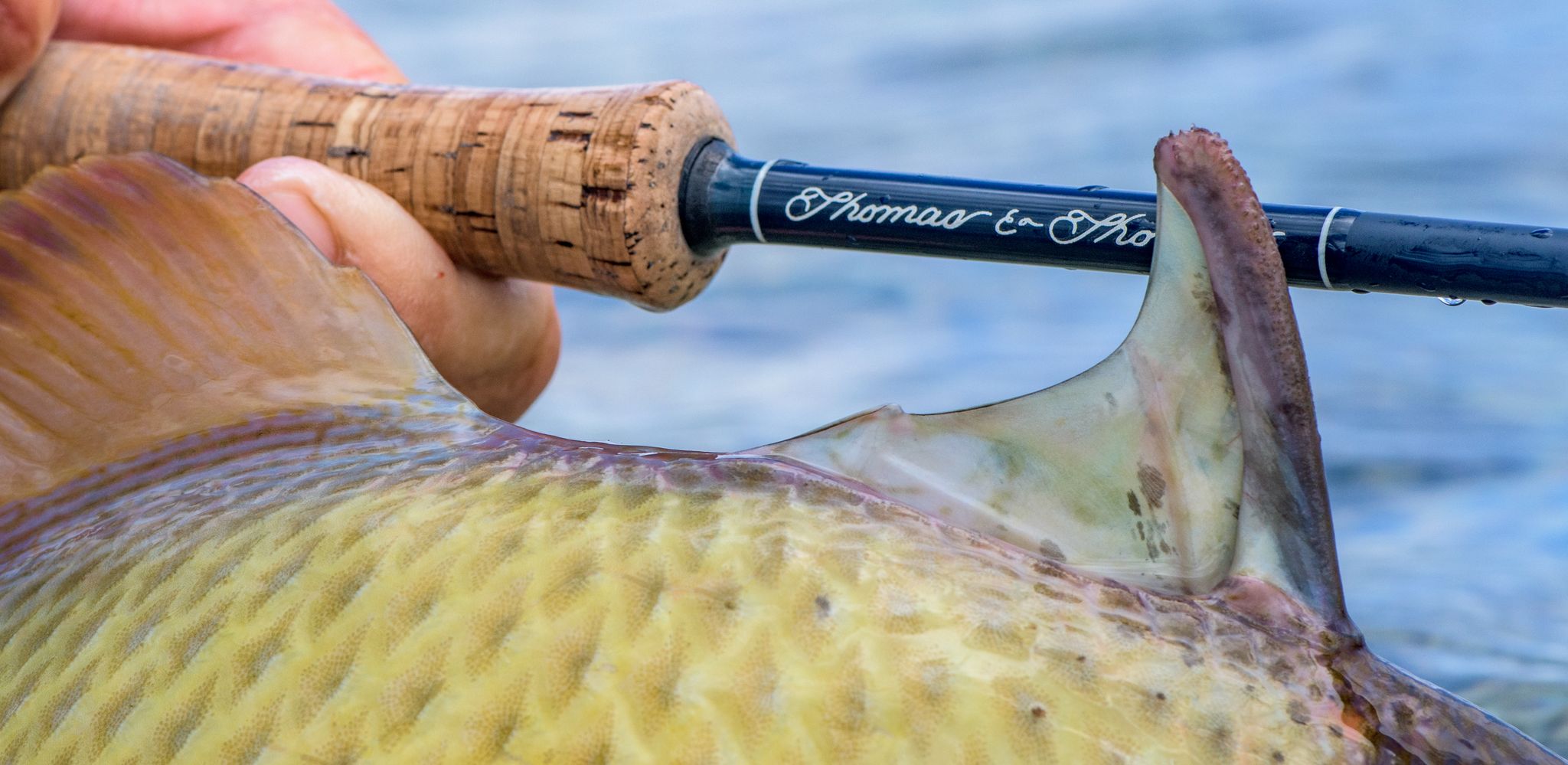 Saltwater fly fishing rods by Thomas and Thomas
Saltwater fly fishing rods by Thomas and Thomas
Selecting the right saltwater fly fishing rod can be a crucial factor in the success of your fishing trip. Here are some factors to consider when choosing a saltwater fly rod:
Line Weight: Line weight refers to the thickness of the fly line and is measured in weight. It is important to match the line weight of your rod with the line weight of your fly line. The weight of the rod being chosen is determined by the fish that are going to be targeted. The bigger and stronger the fish the higher the weight (10-12wt). Conversely the smaller or more finicky the fish are the lower the weight (8-10wt). The relationship between fly rods and fly lines is extremely important and pairing the two is essential to get the best use out of your rod.
Rod Action: Rod action refers to the way a rod bends when casting and fighting a fish. Fast-action rods bend mostly in the tip section, while slow-action rods bend throughout the length of the rod. Fast-action rods are best for making long, accurate casts, while slow-action rods provide more control and sensitivity when fighting a fish.
Rod Length: Saltwater fly rods typically range from 8 to 12 feet in length. Shorter rods are more maneuverable and are best for fishing in tight quarters, while longer rods provide more casting distance and are best for open-water fishing. The standard length of saltwater fly rods is 9ft with some anglers choosing to fish 8 ft8 rods as well.
Material: Saltwater fly rods are typically made of graphite or fiberglass. Graphite rods are lightweight and provide sensitivity, while fiberglass rods are more durable and provide more power.
Price: Saltwater fly rods can range in price from under $100 to several thousand dollars. The cost of a rod will depend on the quality of the materials and the manufacturer.
When selecting a saltwater fly fishing rod, it is important to consider your fishing goals and the species you plan to target. It is also a good idea to test several different rods to find the one that feels comfortable and matches your casting style.
Choosing a saltwater reel
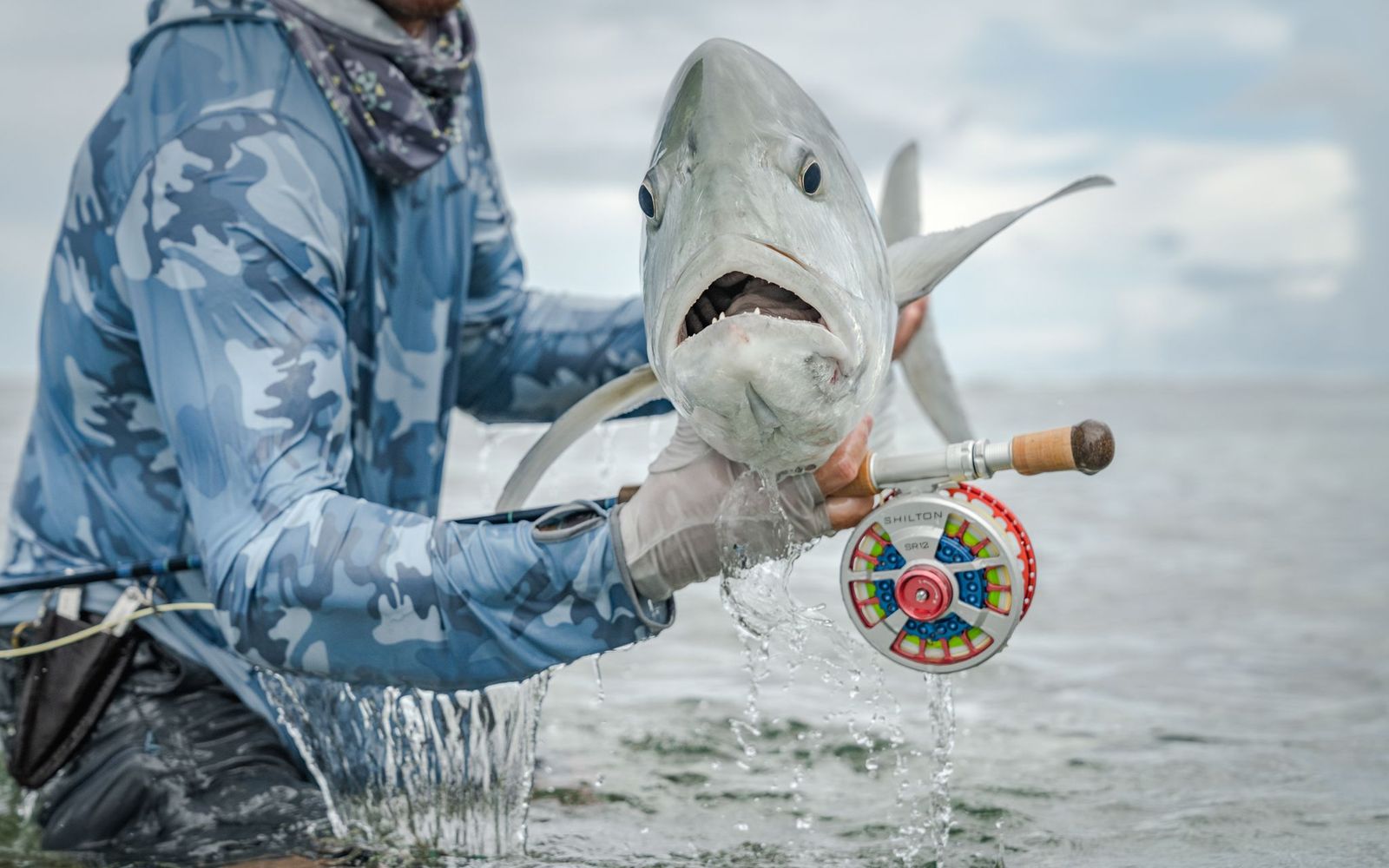 Saltwater fly fishing reels by Shilton
Saltwater fly fishing reels by Shilton
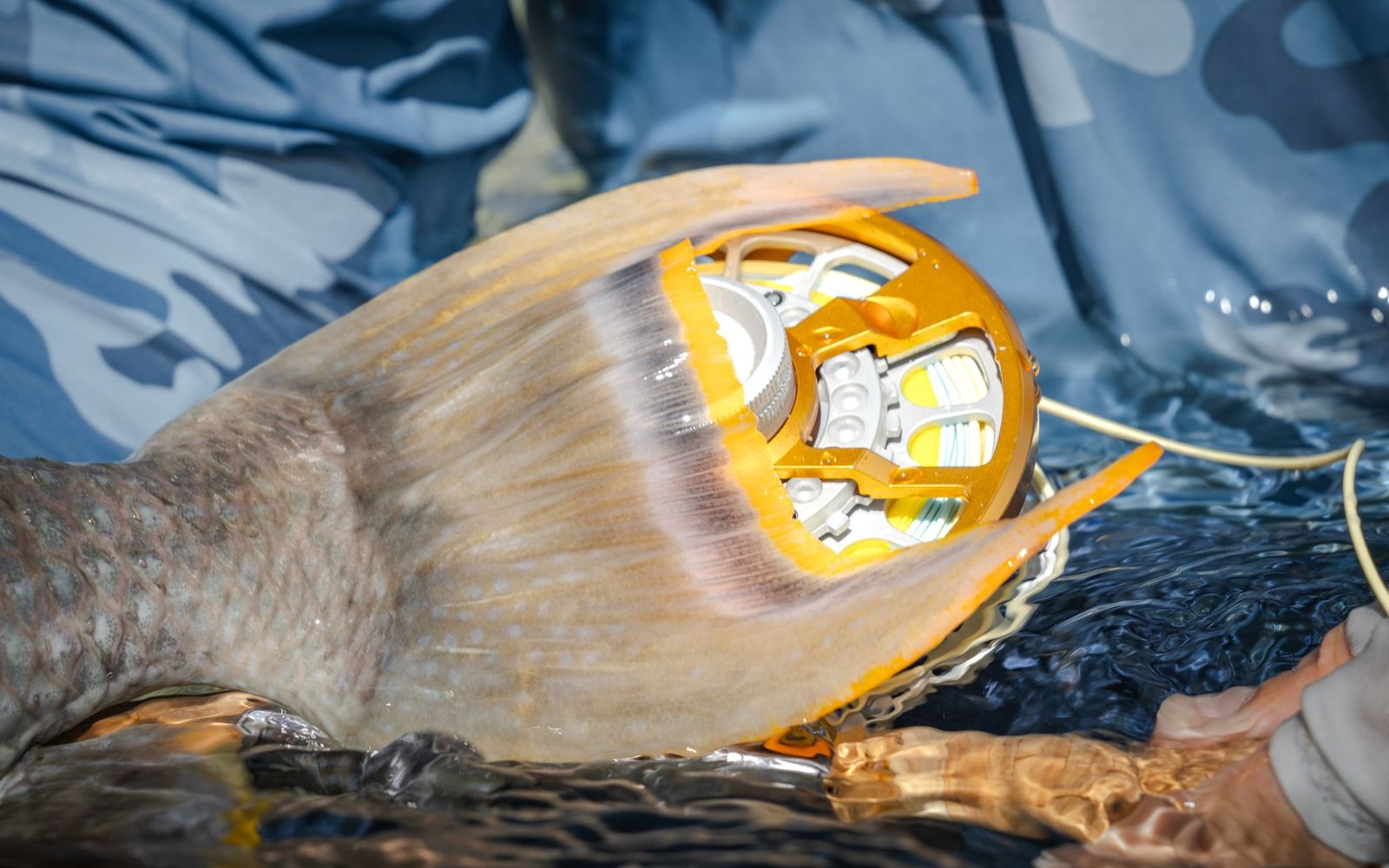 Saltwater fly fishing reels by Shilton
Saltwater fly fishing reels by Shilton
Choosing the right saltwater fly reel is an important decision, as it can impact the performance and durability of your fishing setup. Here are some factors to consider when choosing a saltwater fly reel:
Size/Weight: Reel size is determined by the weight of the rod you have chosen and the capacity of the line the reel needs to hold. larger more robust reels are used for heavier-weighted rods and Bluewater fishing while smaller reels are often used on the flats. one key element in a reel is that it should have a large arbour for fast line retrieval as oceanic fish are fast and take a lot of line.
Drag System: Unlike most freshwater reels the drag on a saltwater reel is crucial and can often make or break catching fish. The drag is a mechanism that controls the resistance of the line being pulled out of the reel. Saltwater drag systems are typically split into two categories, sealed drags and non-sealed. Sealed drag systems are designed to keep water out of the drag system and are often more compact, allowing for the smoothest possible drag. Non-sealed systems can be equally as smooth and are often more robust if well looked after. When considering a reel and its drag the fish being targeted needs to be kept in mind.
Line Capacity: The line capacity of a reel refers to the amount of line it can hold. Typically speaking reels used on the flats hold 300m of 50lb -80lb braid backing and a 90ft fly line. While bluewater reels often hold slightly more backing up to 500m.
Material: Saltwater fly reels are typically made of light and robust metal, with aluminium being the most popular material.
Price: Saltwater fly reels can range in price from under $100 to several thousand dollars. The cost of a reel will depend on the quality of the materials and the manufacturer.
Warranty: Consider the warranty offered by the manufacturer, as this can provide peace of mind and protection in the event of any defects or issues with the reel.
When choosing a saltwater fly reel, it’s important to consider your fishing goals, the species you plan to target, and the conditions you will be fishing in.
When buying a reel for GT fishing in the Seychelles, the reel needs four key components, a large arbor, lots of line capacity, extremely robust and a solid strong drag. The large arbor is used to retrieve line quickly after a big run from a GT, will the line capacity allows for breathing room if a big fish is hooked in the surf? The rigidity or robustness is essential as fishing for GT’s is often done on foot in the surf meaning the reel is consistently submerged in saltwater and being bumped on rocks or on the boat. Lastly and probably the most crucial element is the drag. GT’s are extremely strong and fast if the drag is not sufficient the GT will have free reign and pull the line off your reel so fast that it will be lost due to cutting you off or wrapping you up in the reef. Having a good strong drag will allow you to slow the fish down and gain control over it more easily.
On Alphonse our go-to reels are Shilton Reels which we have used for over 15 years, the reels are used daily and with proper care and cleaning are still running strong. That being said there are many other extremely good brands out there, namely, Mako, Hatch, Orvis, Sage and Tebor.
Review this article from us for more info on Shilton Reels
Choosing the best saltwater fly lines
The industry is saturated with several options that contest the title of the best saltwater fly lines. At all Alphonse Fishing Co. destinations, we proudly stock Cortland line and have yet to be disappointed by any of their products.
Some of the other popular brands are Rio, Scientific Anglers, Orvis and Airflow, which all offer versatility and performance for a wide range of saltwater fly fishing situations.
It’s worth noting that the best saltwater fly line for you may depend on your specific fishing needs, target species, and casting style.
Therefore, it’s always a good idea to consult with experienced anglers, read reviews, and consider your personal preferences before making a final decision on which saltwater fly fishing line which would best suit you.
Line weight: This paired with your rod is essential, the weight of the line chosen is determined by the target species, wind conditions, ease of casting and strength of the species. Similar to what’s been explained above in the rod section higher weighted lines are used for stronger/bigger fish, they also allow for easier casting into the wind, but don’t allow for delicate presentations. On the other hand, lighter weighted lines allow for delicate presentations and thinner leaders but cast less easily into the wind. The most popular line weights used in the salt are 9 and 12 wt lines.
Core: the core of the fly-line is the internal material that the exterior is attached to, this material can either be monofilament or braided, braided cores have become significantly more popular in recent years due to them providing suppleness, longevity, thinner diameters and higher core strengths. While the core material is not a key determining factor in the tropics the strength of the core is, particularly in the higher weight classes. The stronger the core the less chance your fly line is going to snap when pulling a GT hard. Believe it or not, this is a common occurrence in the Seychelles.
Application (Floating, hovering, sinking): Ninety percent of the fly lines used in the salt are floating lines as fish are often sight-fished in shallow water.
Taper vs non-tapered: Almost all fly lines come with a shooting head or taper. This is a must in the salt as it allows fast to be made fast when sight fishing and allows for a better more delicate presentation.
 Cortland GT / tuna saltwater fly fishing lines
Cortland GT / tuna saltwater fly fishing lines
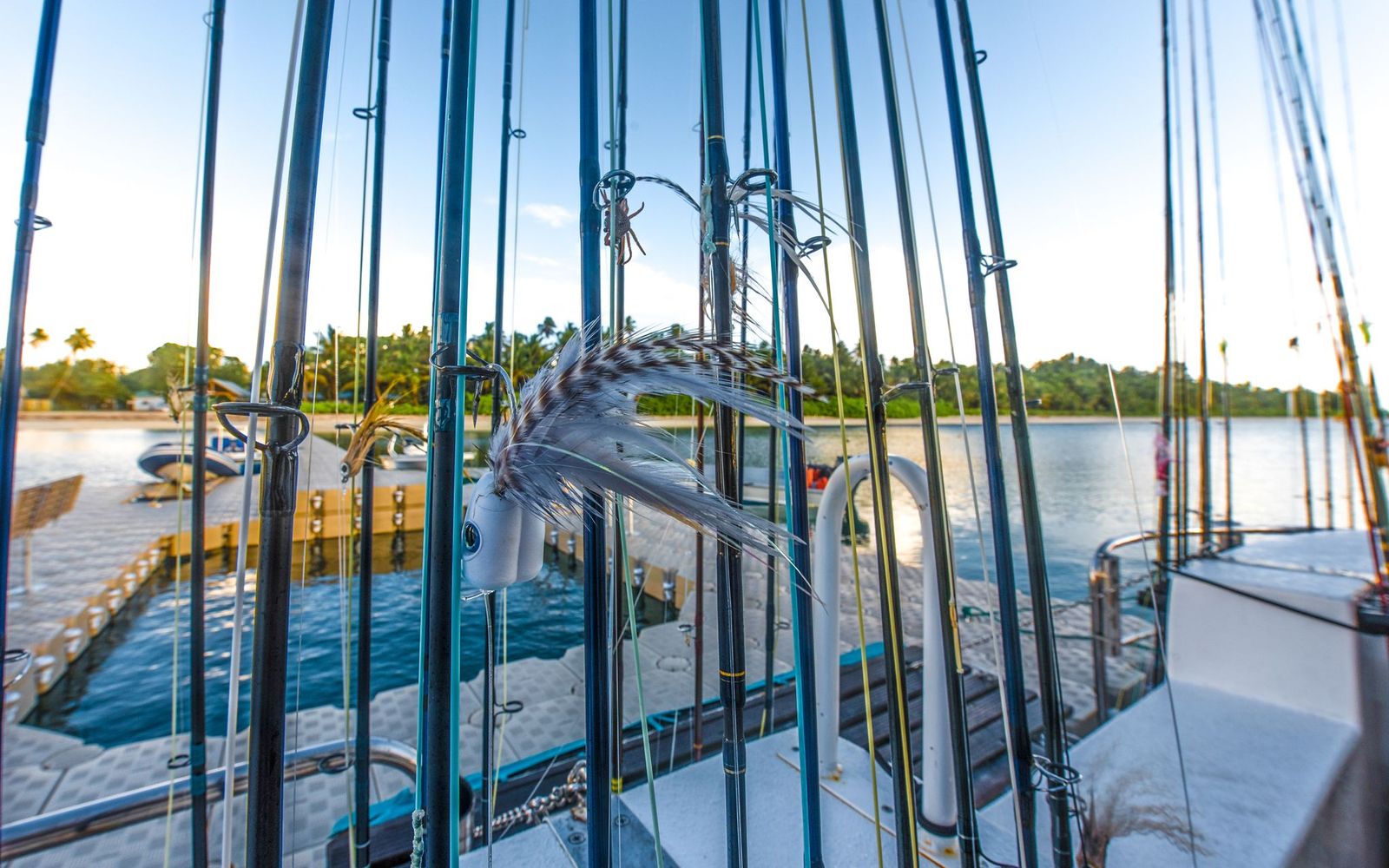 Cortland GT / tuna saltwater fly fishing lines
Cortland GT / tuna saltwater fly fishing lines
Our selection of saltwater flies
Which saltwater flies should I use?
This must be one of the most common questions we receive from guests and anglers in general.
We suggest consulting the guides at your fishing destination as they are likely to be experts in the area and seeking knowledge from them will prevent you from purchasing or making the incorrect flies. Although if you would like to purchase your flies, most destinations will have them on-site for you.
As a general rule for saltwater fly selection, this is what we would suggest; acquaint yourself with the local fish species and their feeding patterns. Research their favorite snacks and match your fly patterns to mimic their treats of choice. Vary your choices to adapt to different conditions – lightweight flies for a delicate presentation, meatier ones for when the waters run wild. Fly selection is a dance between intuition and experimentation.
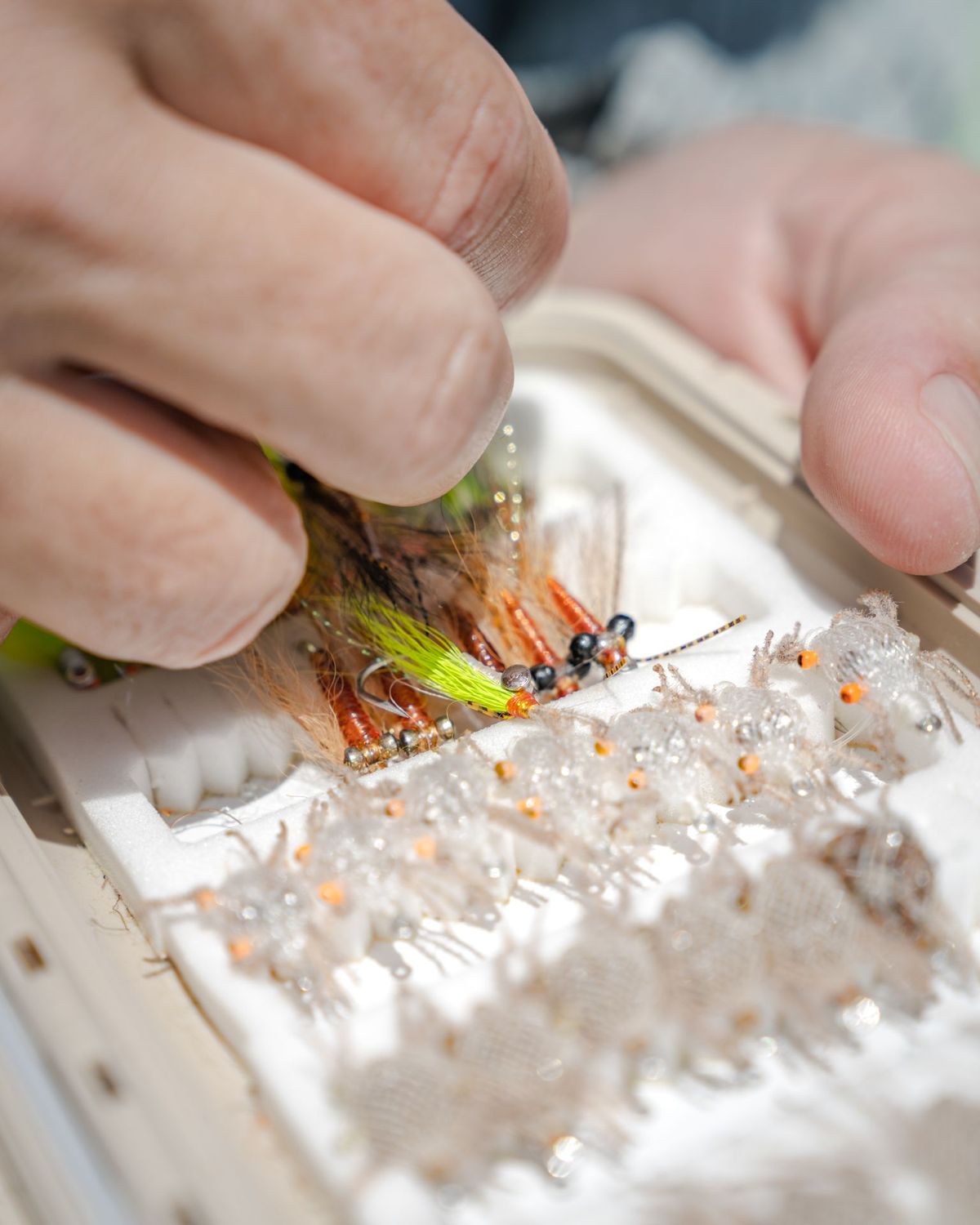 Saltwater fly fishing flies
Saltwater fly fishing flies
 Brush fly for giant trevally
Brush fly for giant trevally
There are a few patterns that we always opt for while electing saltwater flies for certain species, here is some very valuable fly information on the main five species we target in the Seychelles Outer Islands:
- Giant trevally best flies
- Bonefish best flies
- Indo-pacific permit best flies
- Triggerfish best files
- Milkfish best flies
 Saltwater fly fishing flies
Saltwater fly fishing flies
 Flies for bonefish
Flies for bonefish
Some additional saltwater fly pattern information can be found at the links below:
- Bonefish
- Indo-Pacific permit
- Triggerfish
- Yellowfin tuna
- Milkfish
- Bluefin trevally
- Barracuda
- Giant trevally
- Wahoo
Saltwater fly-tying techniques
When it comes to saltwater fly-tying techniques, there are various resources available that provide step-by-step instructions and tips for tying effective saltwater flies.
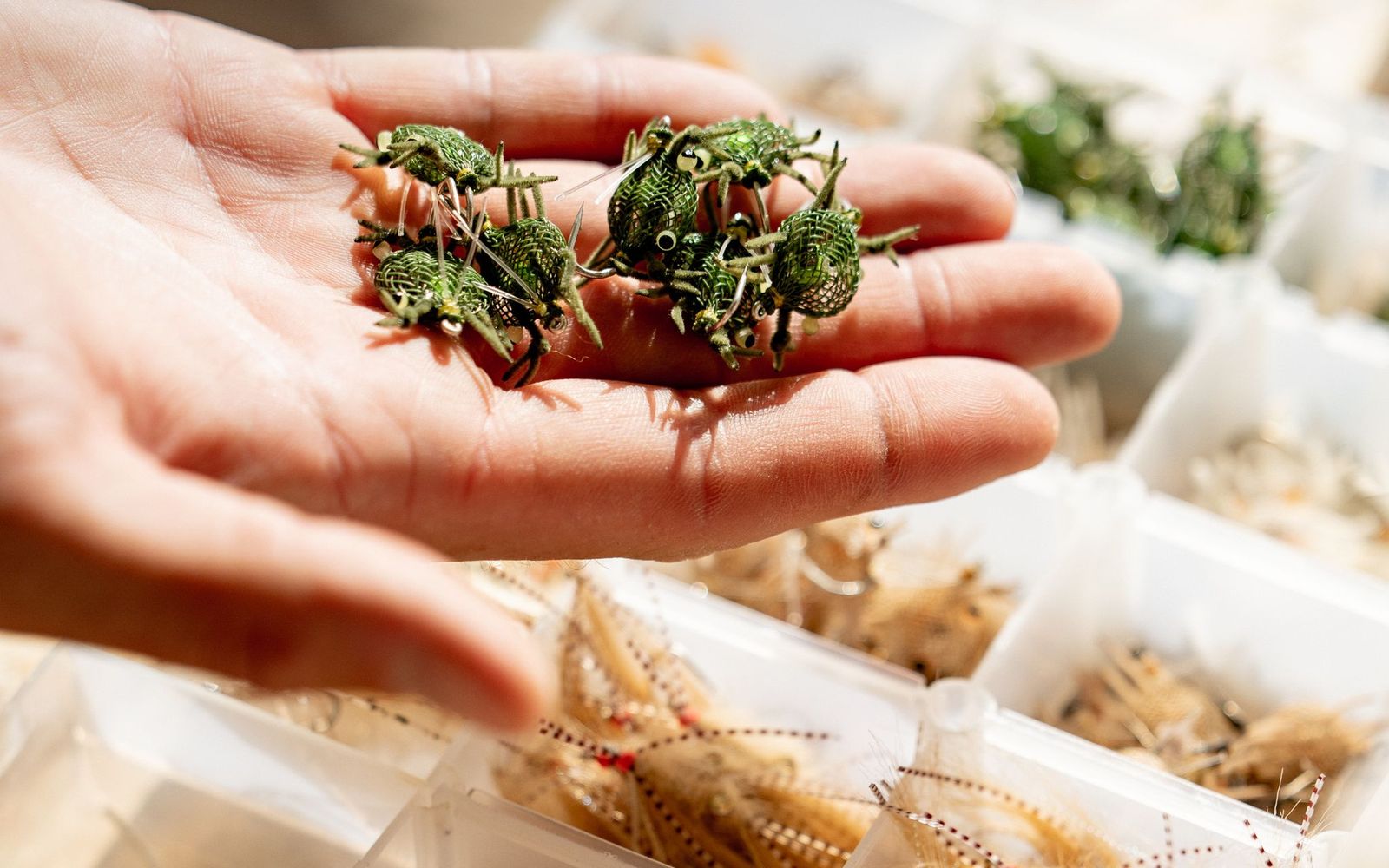 Alphlexo crab flies
Alphlexo crab flies
Our fly-tying techniques
Alphonse Fishing Co has spent some time making in-depth fly-tying videos for a few of the common saltwater flies we use at our destinations:
- Spawning Shrimp Fly
- Golden Knight Fly
- AlphlexoCrab Fly
- Alphlexo Crab Wax Fly
- Not-your-average-popper (NYAP) Fly
- Baby Clouser Fly
- Little Red Riding Hood Fly
- Semper Fly
- James’ Sand Prawn Fly
- Flaming Lamborghini Fly
- Garlic Butter Fly
For beginners interested in saltwater fly-tying, the Salty Fly Tying – Learn Saltwater Fly Tying Patterns blog offers a dedicated post on getting started with tools, materials, and tips for tying saltwater flies]. It covers important aspects such as lighting, which is crucial to avoid straining your eyes during long tying sessions.
Another resource worth exploring is the Fly Lords Magazine – 5 Saltwater Flies Everyone Should Know How to Tie, which highlights essential saltwater flies and their significance in different fisheries. The article discusses the Clouser fly, developed by Bob Clouser, as well as other popular patterns.
By exploring these resources, you can gain valuable insights and guidance on saltwater fly-tying techniques, enabling you to create effective patterns for your saltwater fly fishing adventures.
Saltwater fly fishing techniques, tips & lessons
With the general elements of your fly fishing gear like rods and reels out the way, you need to be able to use them in unison, along with your flies, to actually achieve the catch your after. This all comes down to technique.
We touched on a few flies above, and while shop-bought flies often do the trick, there is something extra special about an angler catching a fish on a fly that they themselves have tied. Read further below for more info on fly-tying, casting techniques and stripping techniques.
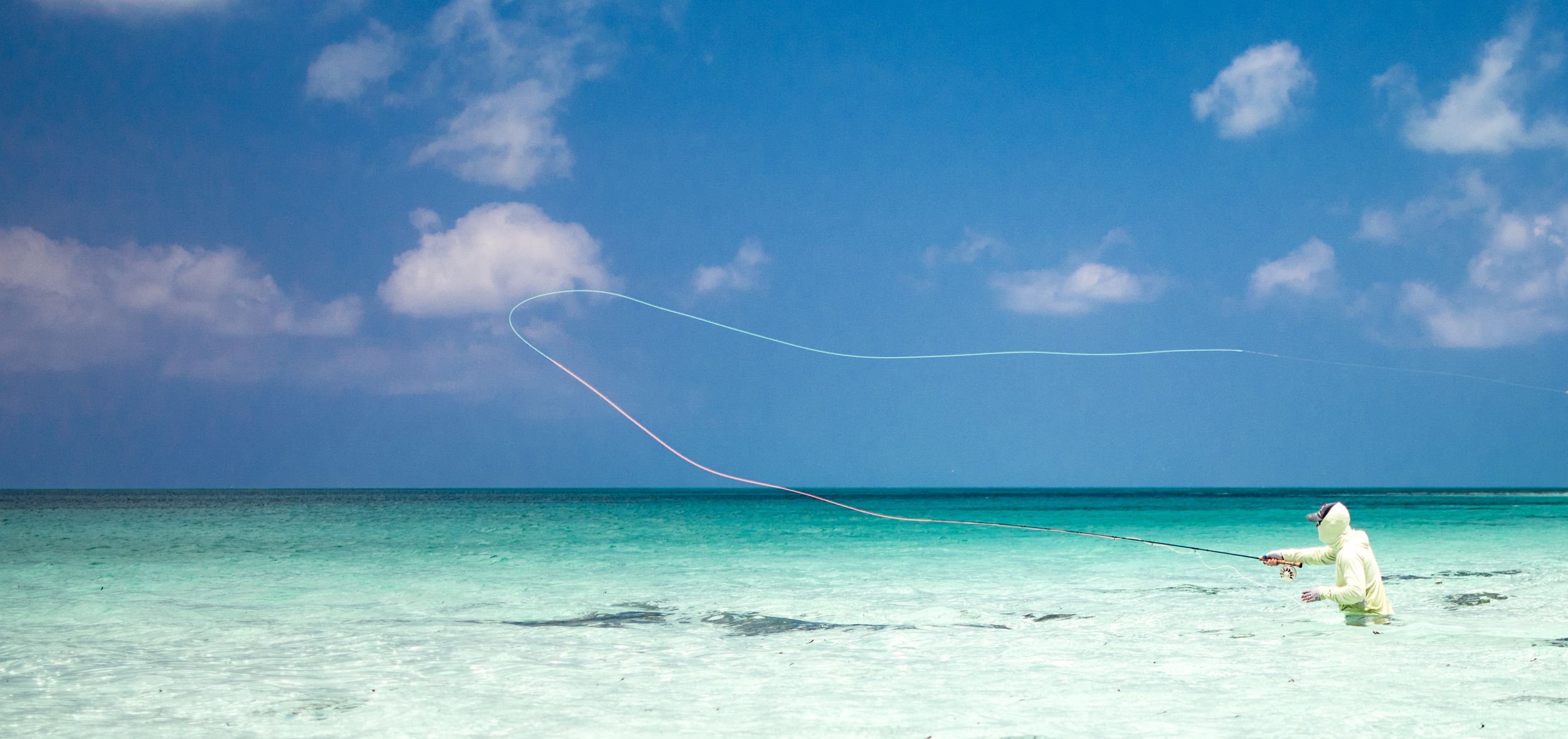 Fly fishing angler casting
Fly fishing angler casting
Saltwater fly casting techniques
There are several valuable resources available to guide you in honing your saltwater fly-casting skills. Moon Cast Anglers offer insights into casting techniques specifically tailored for saltwater fly fishing, including the double haul and backcast presentations. American Angler also shares valuable tips, emphasizing the importance of the double haul for easier casting and longer presentations. Additionally, Trouts Fly Fishing provides useful advice on improving saltwater casting, such as practising with shorter lengths of fly lines and aiming for tight loops. For visual learners, watching videos on YouTube can be beneficial.
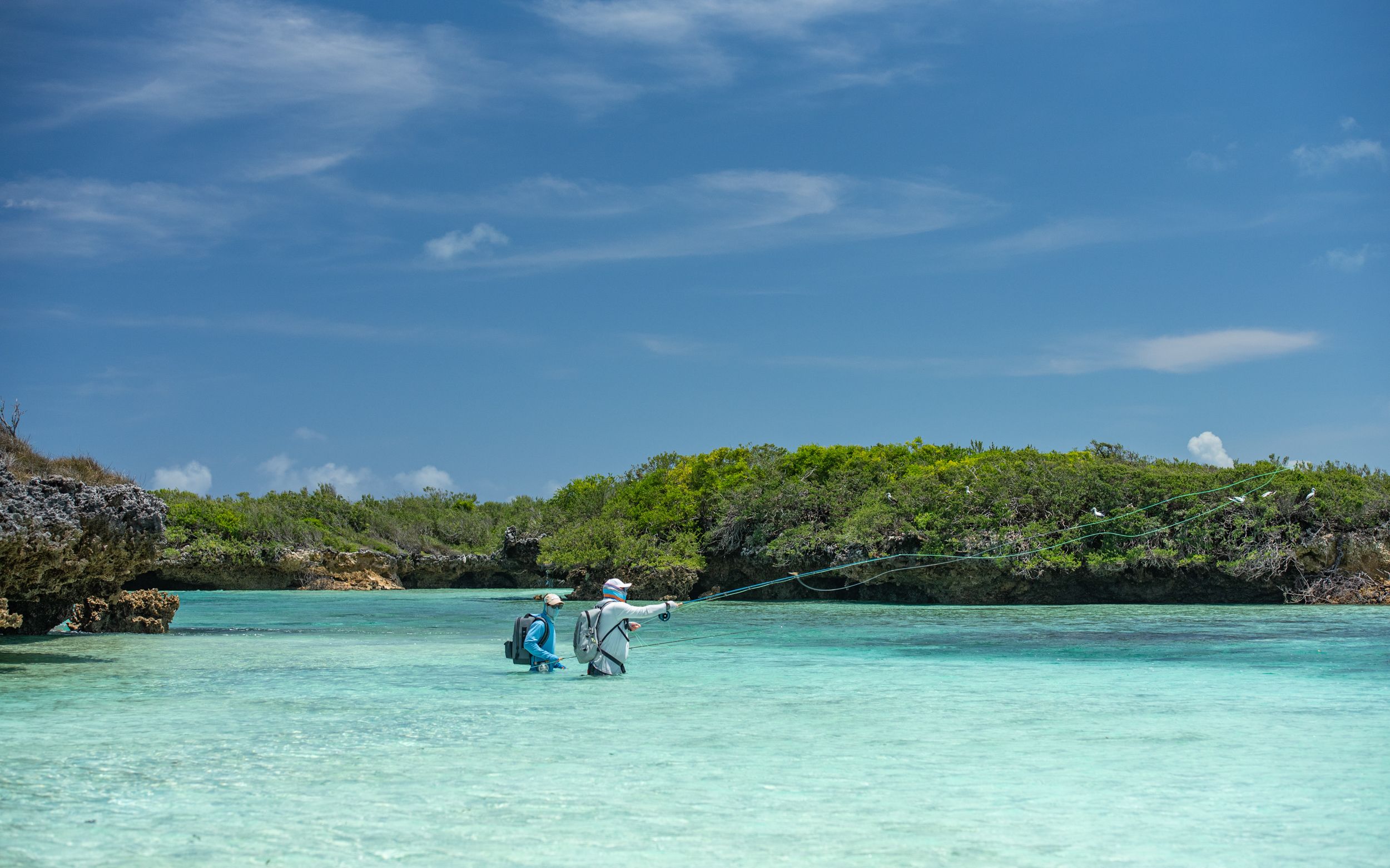 Casting techniques for saltwater fly fishing
Casting techniques for saltwater fly fishing
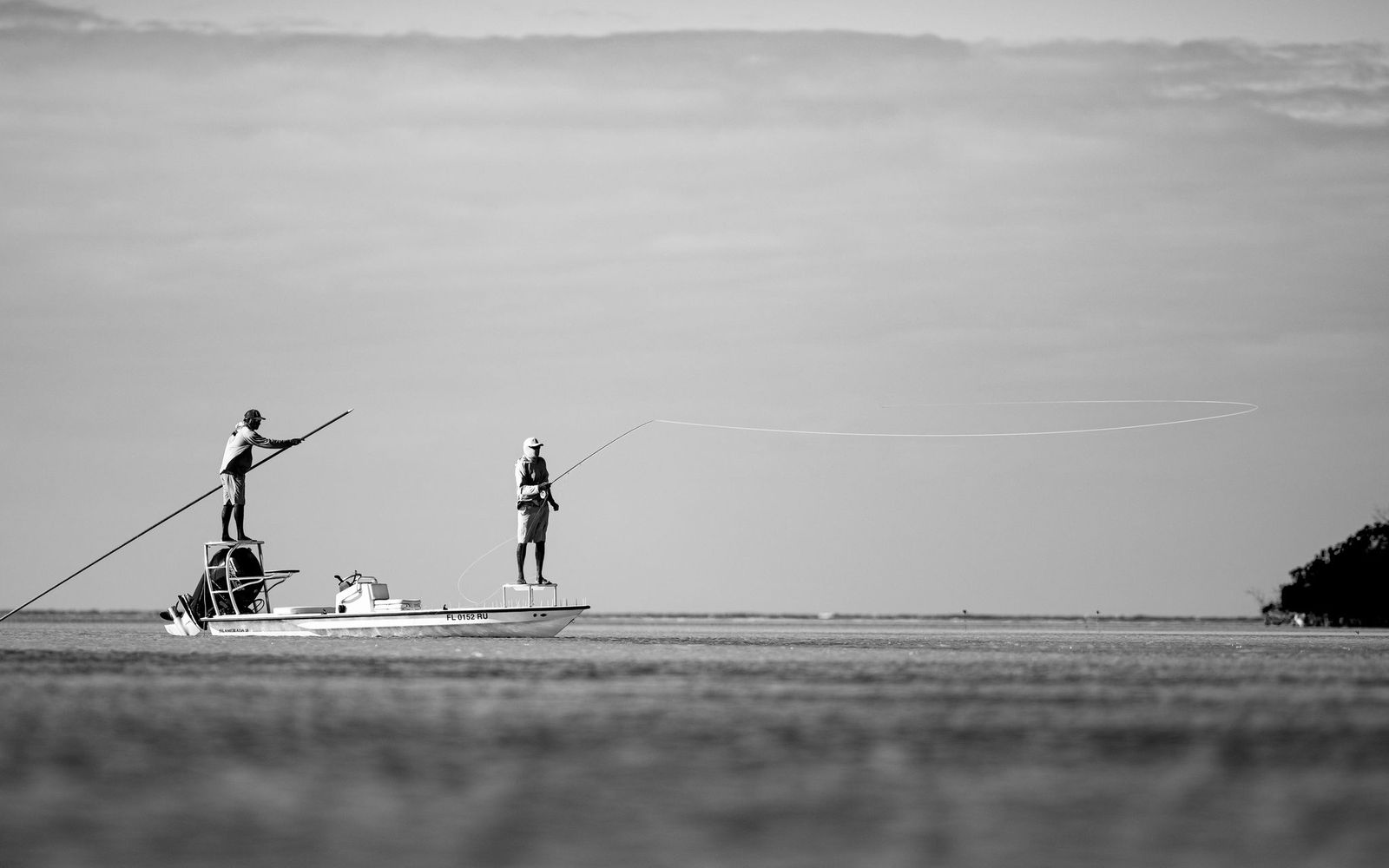 Casting techniques for saltwater fly fishing
Casting techniques for saltwater fly fishing
Mastering the double haul can greatly improve your line speed and casting distance. By using your non-dominant hand to pull the line on the casting stroke, you can load the rod more deeply and transfer greater energy into your cast.
Practice and a willingness to continuously learn and refine your techniques are key to becoming a proficient saltwater fly caster.
Saltwater fly fishing stripping techniques
When it comes to saltwater fly fishing stripping techniques, there are a few key approaches that can enhance your success on the water. One technique to consider is the two-handed strip retrieval. Not only does this technique provide a better presentation, but it also helps prevent the common mistake of “trout setting”.
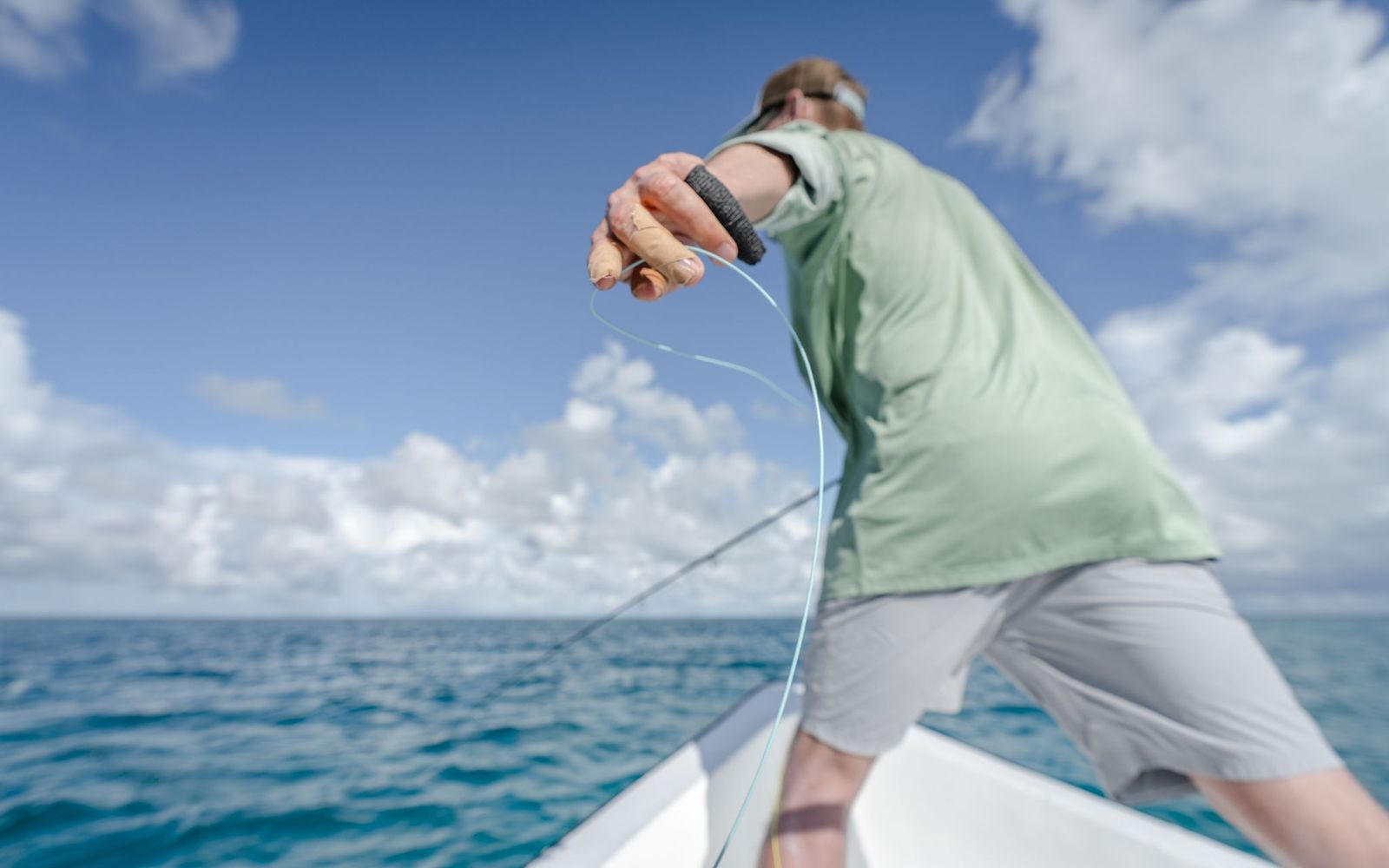 Strip set technique
Strip set technique
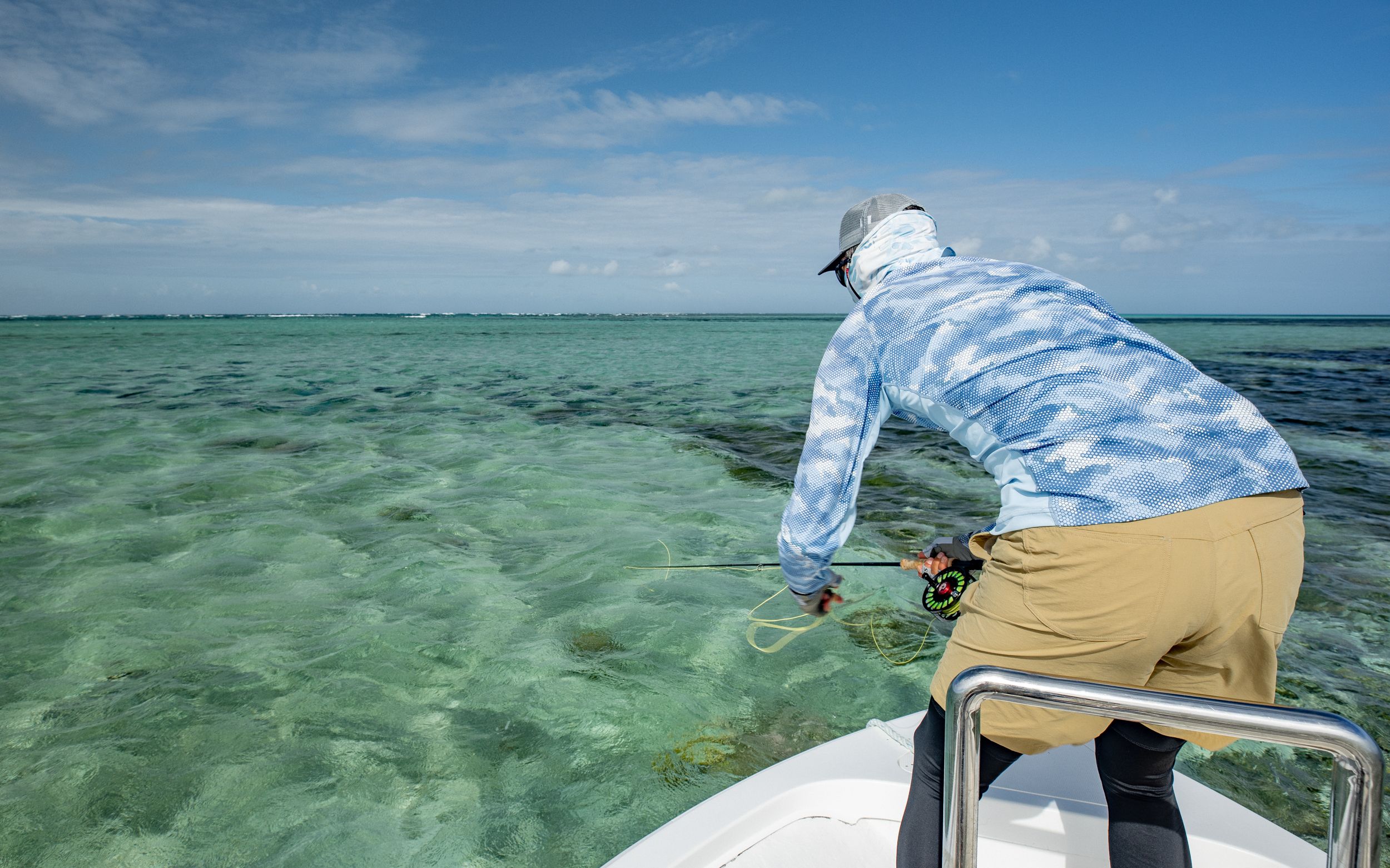 Keeping your rod tip down while stripping
Keeping your rod tip down while stripping
Another important technique is the strip set, which involves tugging the line towards you, or more often past you when you feel the fish take. This proper set technique ensures that the fly stays connected to the fish, increasing your chances of a successful hook-up.
The MOST IMPORTANT thing when stripping is to keep your rod tip down, your guide may sound like a stuck record reminding you of this, but it is crucial in successfully hooking up a fish. Remember, practice and experimentation will help you refine these techniques and find what works best for you in different fishing conditions
Things to know when fly fishing in the ocean
Tides & Currents
Tides play a significant role in saltwater fly fishing, as they can greatly impact the behaviour of fish and their feeding patterns. Here are some ways tides can influence fly fishing in the ocean:
 Tides influencing the fish eating patterns
Tides influencing the fish eating patterns
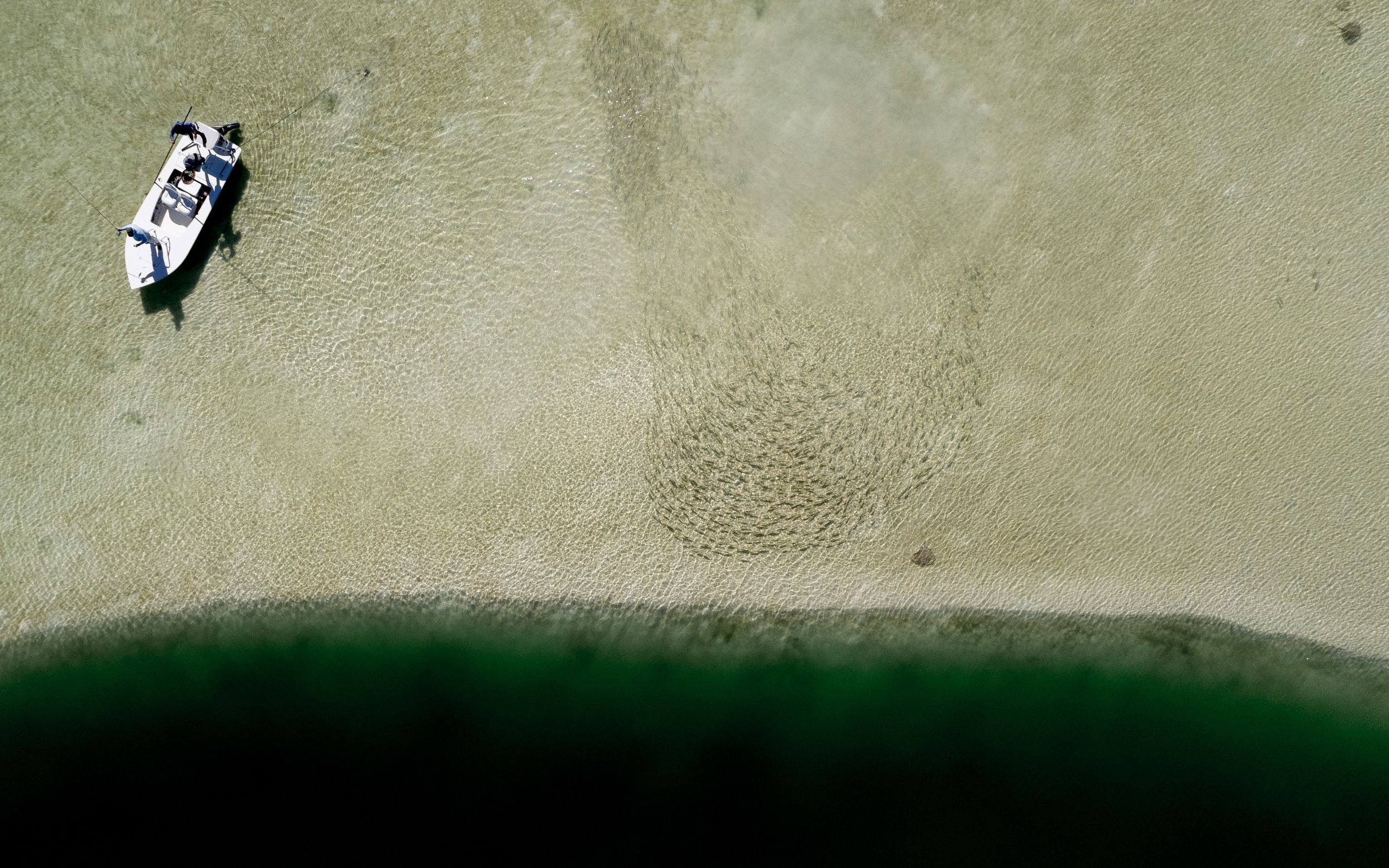 Tides, water movement, water depth and food availability all greatly affect fly fishing in the ocean
Tides, water movement, water depth and food availability all greatly affect fly fishing in the ocean
Water Movement: Tides create currents that can move water and baitfish, which can attract predatory fish such as bonefish, tarpon, and permit. Understanding the timing and strength of tidal currents can help anglers predict the location of feeding fish.
Water Depth: Tides can dramatically change the depth of a fishing spot, affecting the visibility of fish and the type of fly that should be used.
Food Availability: Tides can influence the distribution of baitfish and other prey species, which can impact where predatory fish are likely to be found.
 Most of the Seychelles Outer Islands boast vast wadeable flats in warm water
Most of the Seychelles Outer Islands boast vast wadeable flats in warm water
Cover and Structure: Tides can uncover and reveal underwater structures, such as rocks and reefs, that can provide cover and habitat for fish.
Wading Conditions: Tides can affect the depth and stability of wading conditions, and in some cases, may make wading unsafe or impossible.
Anglers should take tides into consideration when planning a saltwater fly fishing trip, as they can have a major impact on the fishing conditions and the success of the trip.
Weather
Weather can have a significant impact on saltwater fly fishing, and anglers should consider it when planning their trips. Here are some ways weather can influence fly fishing:
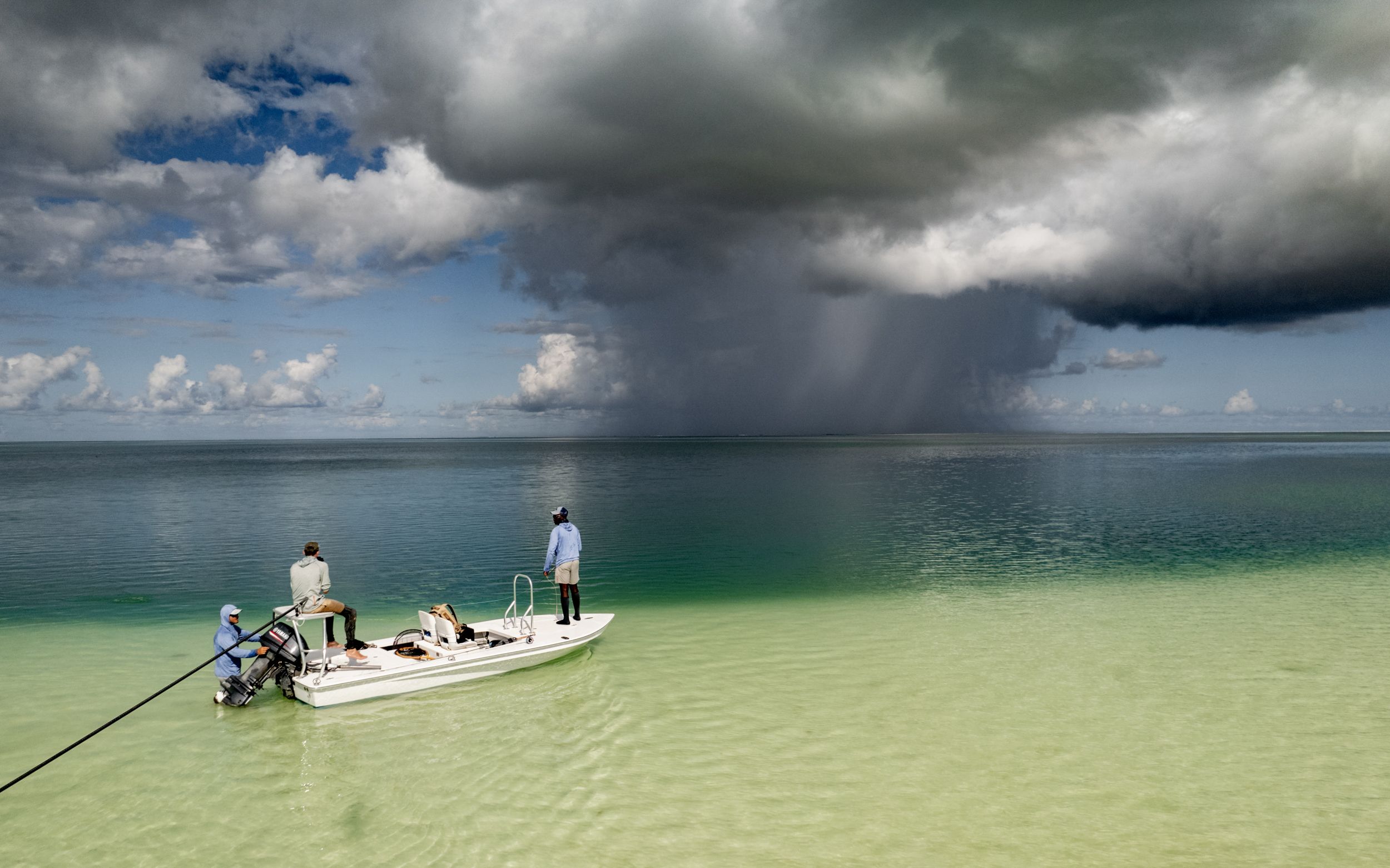 Various aspects of the weather affect your approach to fly fishing in saltwater
Various aspects of the weather affect your approach to fly fishing in saltwater
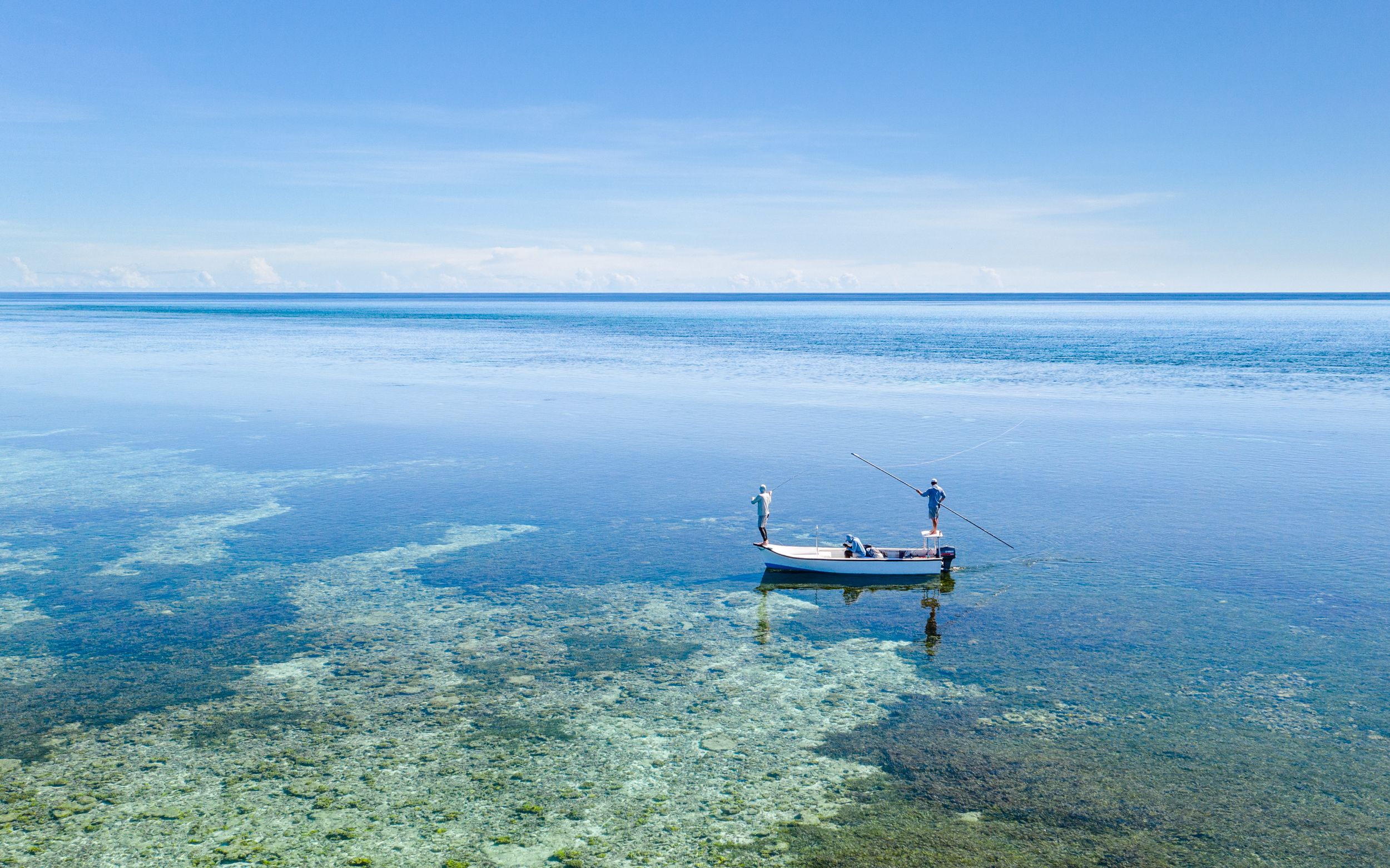 Various aspects of the weather affect your approach to fly fishing in saltwater
Various aspects of the weather affect your approach to fly fishing in saltwater
Water Clarity: Changes in weather can affect water clarity, making it harder or easier to see fish. Wind and rain can create murky water, while sunny days can make the water clear.
Water Temperature: Changes in air temperature can influence the water temperature, which can impact the behavior of fish. Cold fronts can cause fish to become less active, while warm fronts can trigger a feeding frenzy.
Barometric Pressure: Changes in barometric pressure can impact the behavior of fish, as some species are more sensitive to pressure changes than others.
Wind: Strong winds can create rough water conditions, making it difficult to cast and present the fly effectively. They can also change the direction and speed of the water, impacting the location and behavior of fish.
Cloud Cover: Cloud cover can affect water temperature and light penetration, and can make it easier or harder to see fish.
Thunderstorms: Thunderstorms can create hazardous conditions, especially when fishing in open water. They can also cause changes in water temperature, water clarity, and wind direction.
Anglers should monitor weather conditions before and during their fishing trips, and be prepared for any changes that may impact their fishing success.
The fly fisherman’s guide to finding fish in the ocean
There is a lot of lingo used in the fly fishing industry, here are some phrases to familiarise yourself with!
Poling or Paddle: When fishing from a flats skiff, the guide uses a long pole or paddle to navigate the shallow waters, making minimal noise and disturbance to help spot fish.
Wading: Wading in shallow water allows the angler to approach fish quietly and get a close look at their behavior.
Glassing: Use polarized sunglasses to reduce glare on the water and get a clear view of fish swimming below the surface.
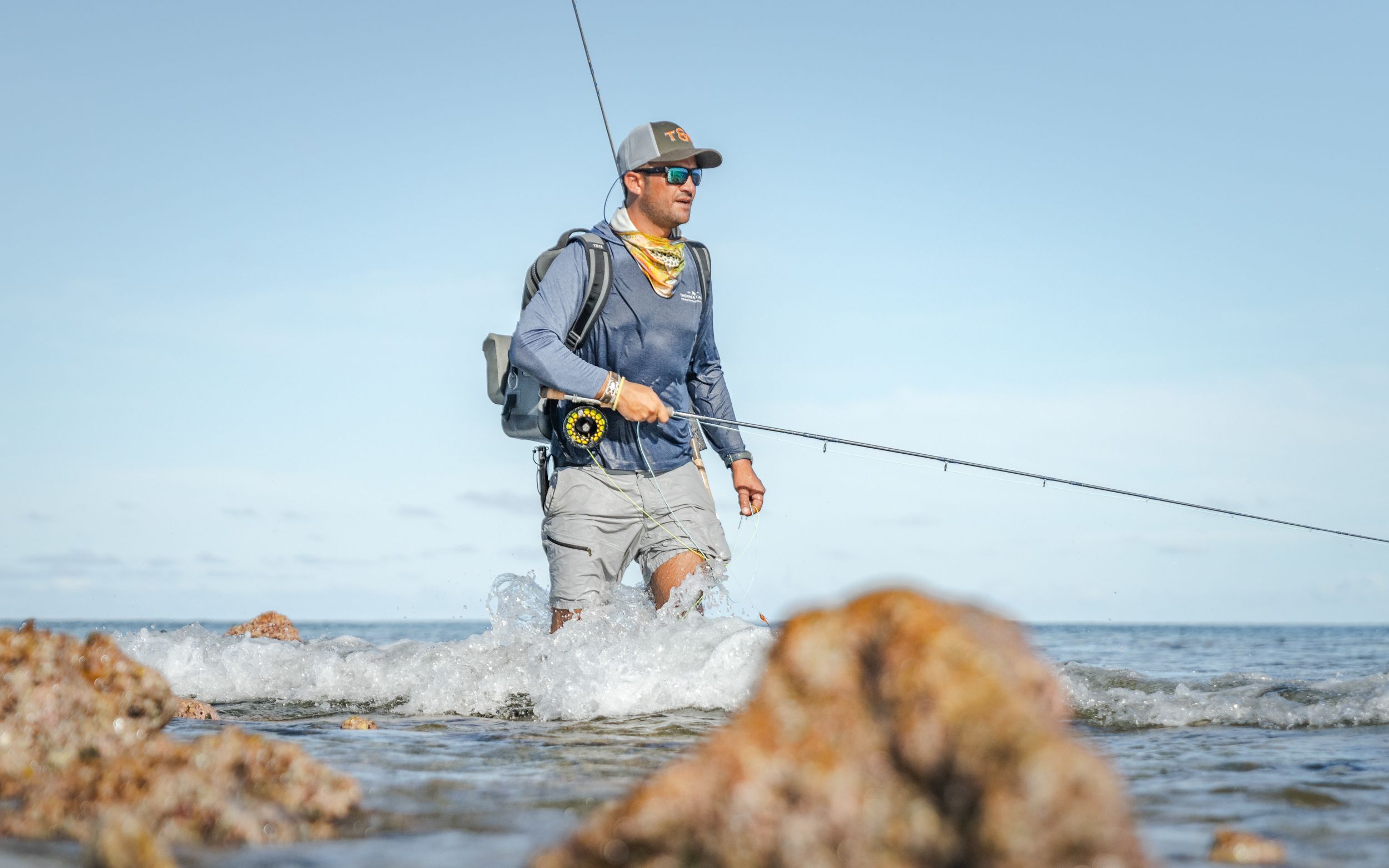 Wading is one of the most common ways in which anglers traverse the flats while fly fishing
Wading is one of the most common ways in which anglers traverse the flats while fly fishing
 Poling the flats with a skiff is another great way to stalk the fish
Poling the flats with a skiff is another great way to stalk the fish
Stealth: Moving slowly and quietly to avoid spooking the fish.
Presentation: Making accurate casts to present the fly to the fish in a natural and enticing manner.
Imitation: Select the right fly pattern that imitates the natural prey of the target species.
Leader and Tippet: Selecting the right length and strength of the leader and tippet to minimize visibility and avoid spooking the fish.
Reading the Water: Understanding the behavior of fish in relation to water currents, tides, and structure to help predict their location and movements.
Our fly fishing trips, islands & packages
More about our packages here
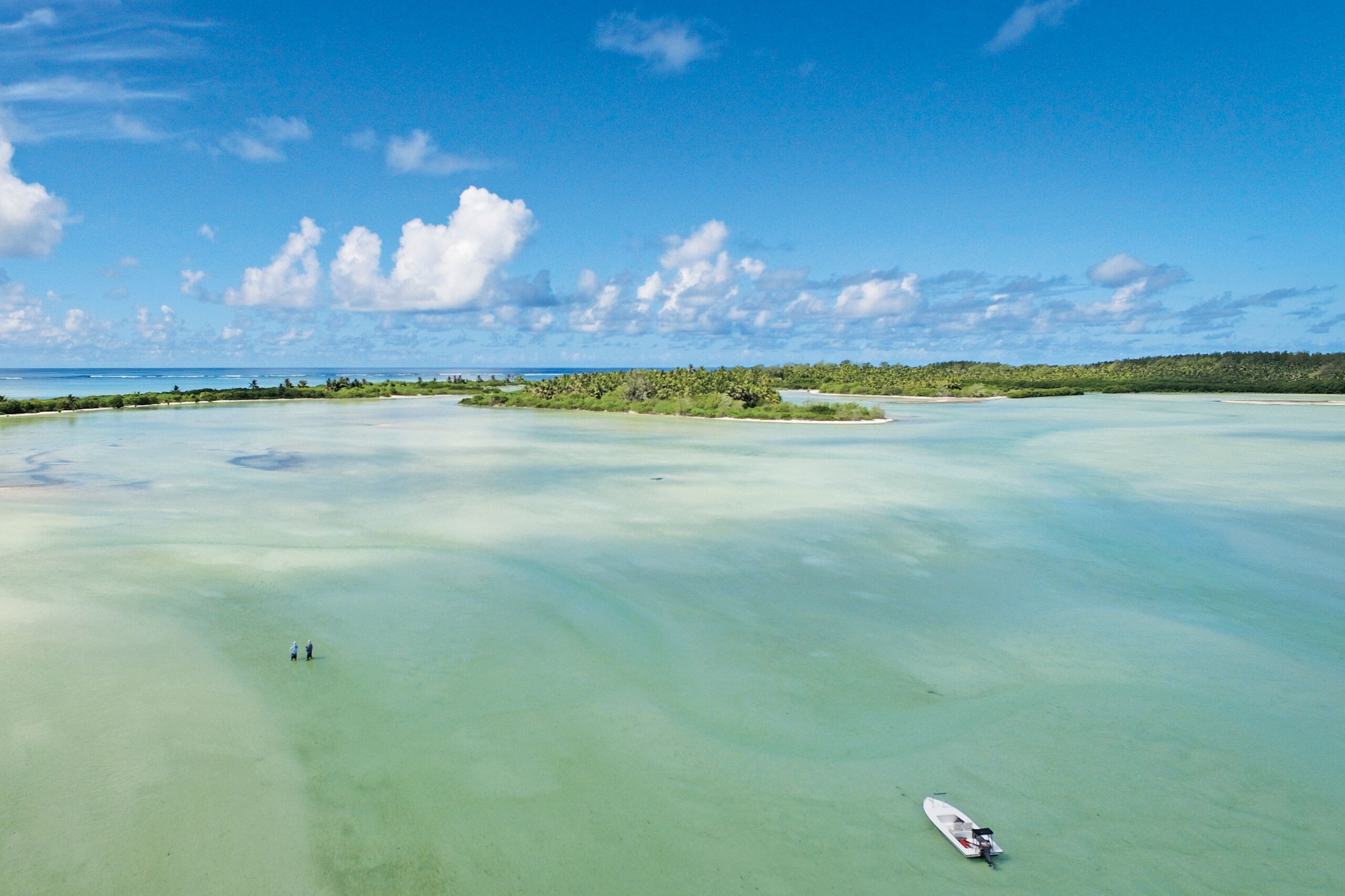 Remote nature to experience whilst fly fishing with Alphonse Fishing Company
Remote nature to experience whilst fly fishing with Alphonse Fishing Company
The types of saltwater fish to fly fish at our island in the Seychelles
The Seychelles is a popular destination for saltwater fly fishing, with a diverse range of species that can be targeted on the fly. Here are some of the most common fish species found in the waters of the Seychelles that are popular to target with fly fishing:
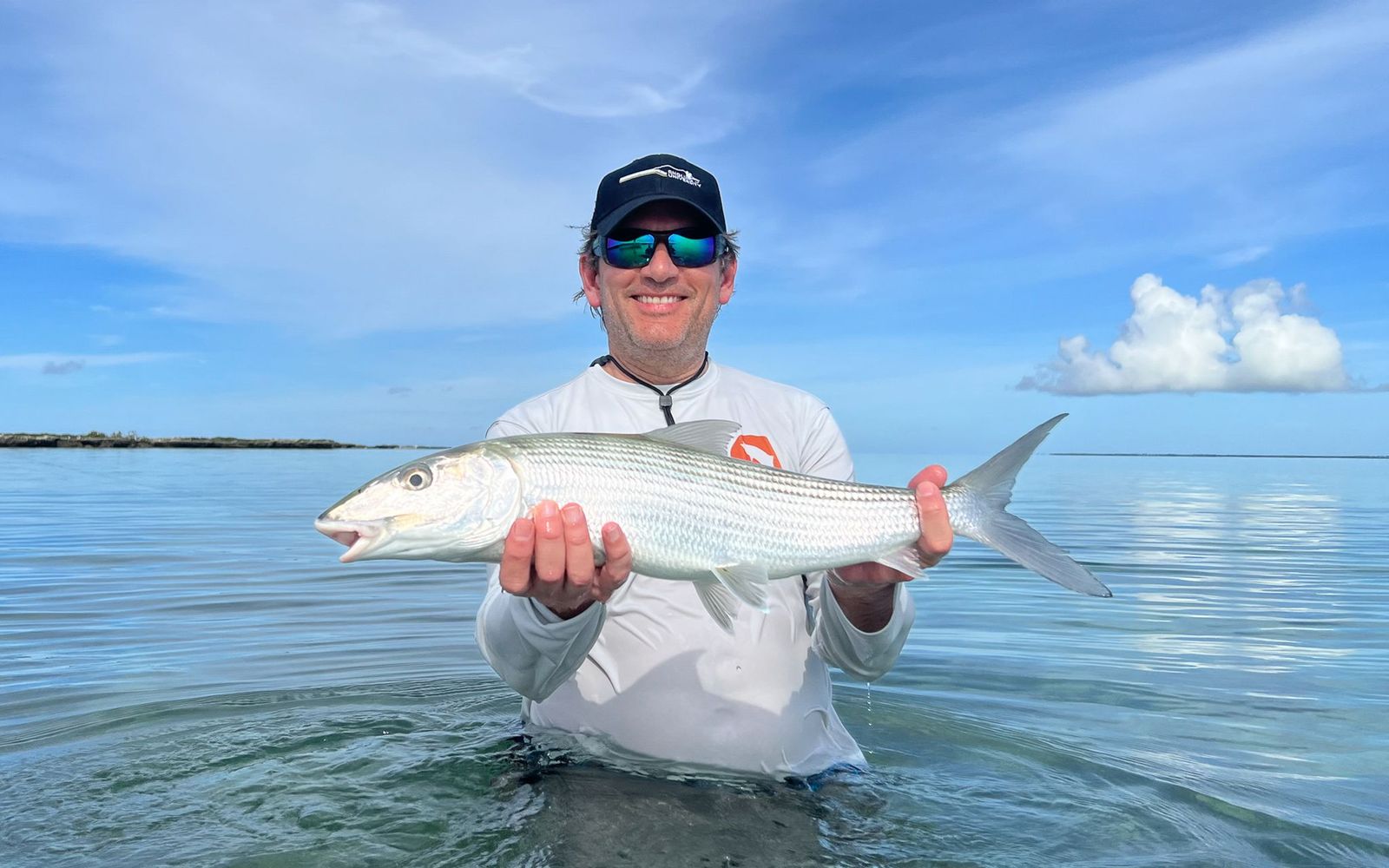 An angler with a bonefish caught at AFC destinations
An angler with a bonefish caught at AFC destinations
 An angler with a bonefish caught at AFC destinations
An angler with a bonefish caught at AFC destinations
Bonefish: bonefish are one of the most popular species to target in the Seychelles. They are found in shallow waters and are known for their powerful runs and quick, acrobatic jumps.
Discover more about bonefish here
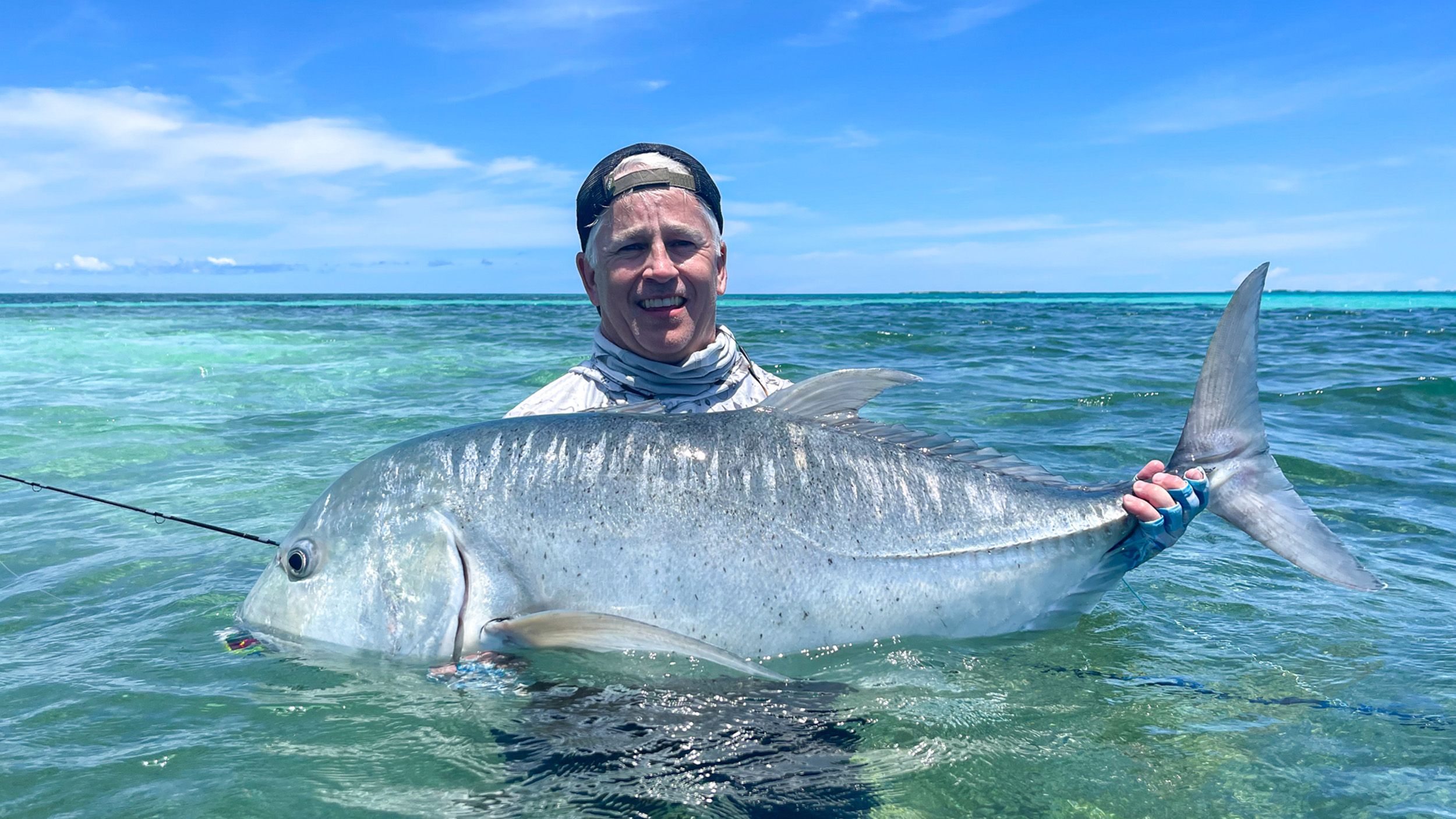 Angler with GT caught at AFC destinations
Angler with GT caught at AFC destinations
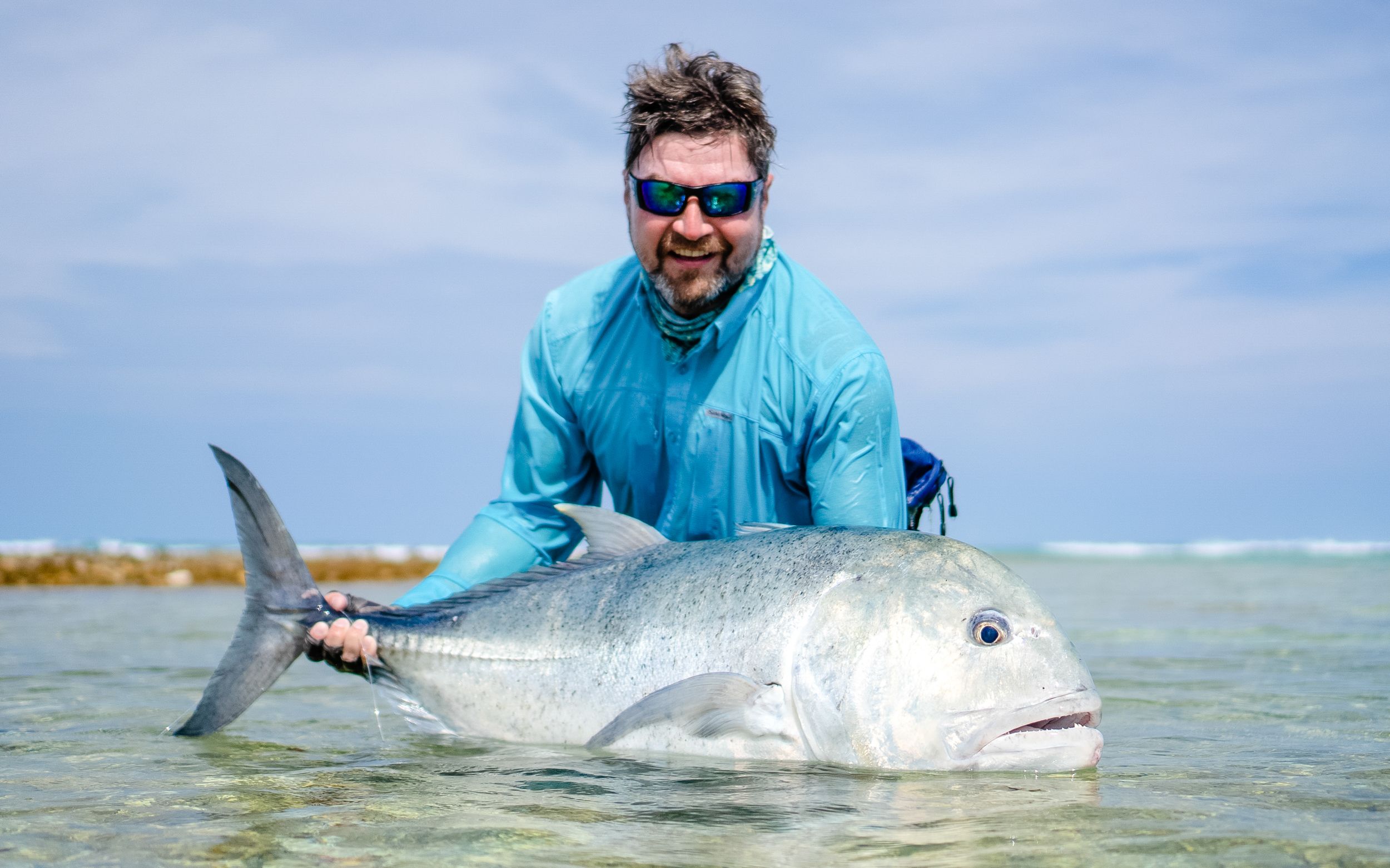 Angler with GT caught at AFC destinations
Angler with GT caught at AFC destinations
Giant Trevally: giant trevally is one of the largest species of trevally, and is prized by fly anglers for its strength and tenacity. They are found in deep water and around offshore structures.
Discover more about giant trevally here
 Angler with a yellowfin tuna caught on a fly
Angler with a yellowfin tuna caught on a fly
Tuna: Tuna are found in the deeper waters of the Seychelles and are known for their speed, endurance, and powerful runs.
Discover more about yellowfin tune here
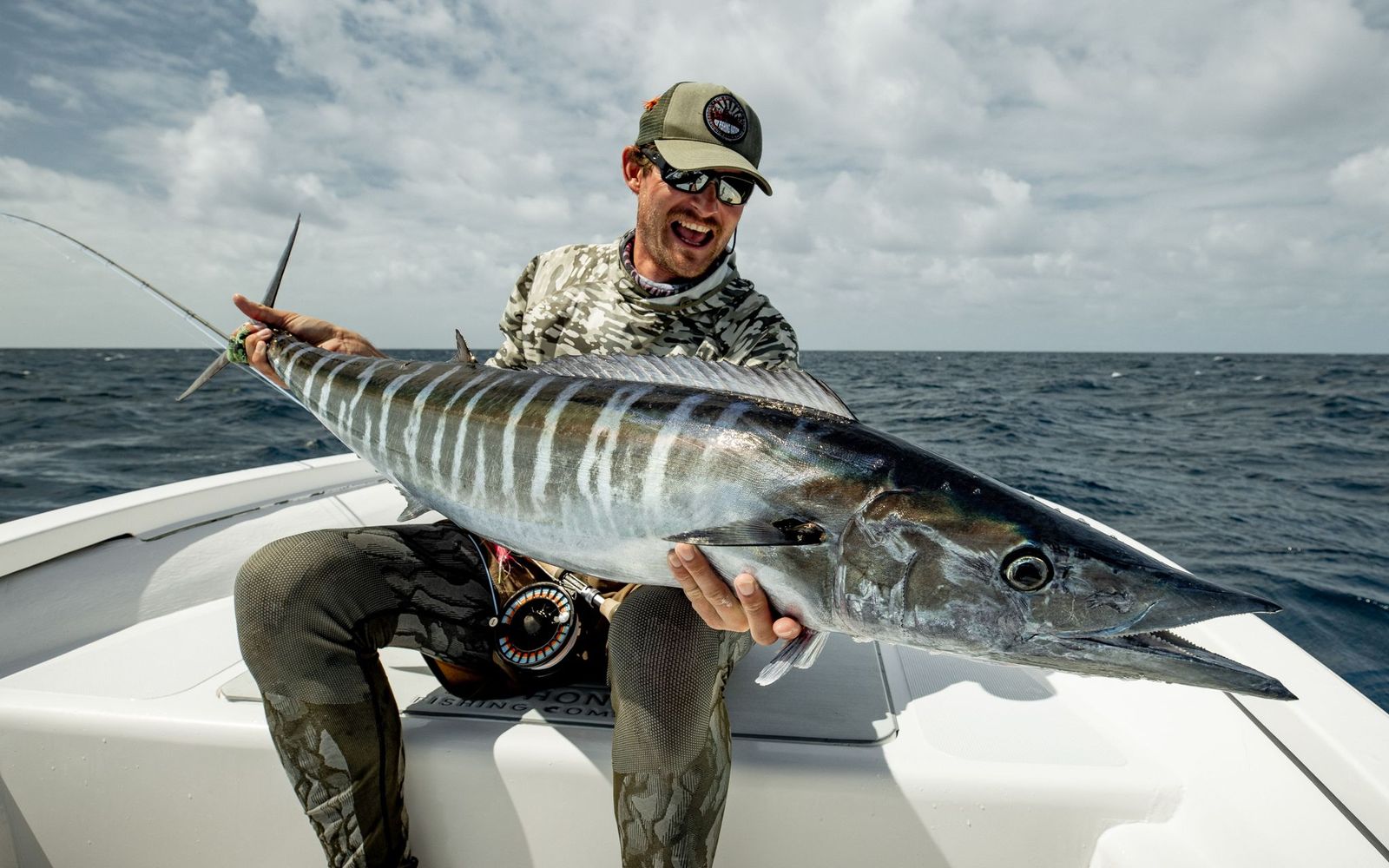 Angler with a wahoo caught on a fly
Angler with a wahoo caught on a fly
Wahoo: Wahoos are a fast-swimming species that are found in the open waters of the Seychelles. They are known for their lightning-fast strikes and powerful runs.
Discover more about wahoo here
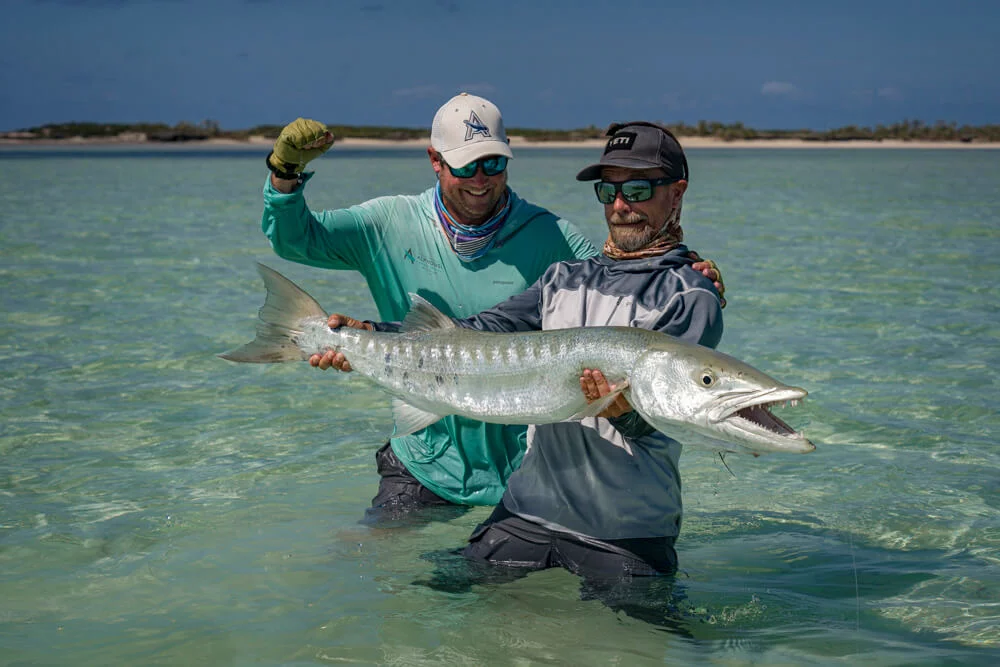 Angler with a barracuda caught on a fly
Angler with a barracuda caught on a fly
Barracuda: Barracuda are predatory fish that are found in the waters of the Seychelles. They are known for their aggressive strikes and speed and can provide an exciting challenge for fly anglers.
Discover more about barracuda here
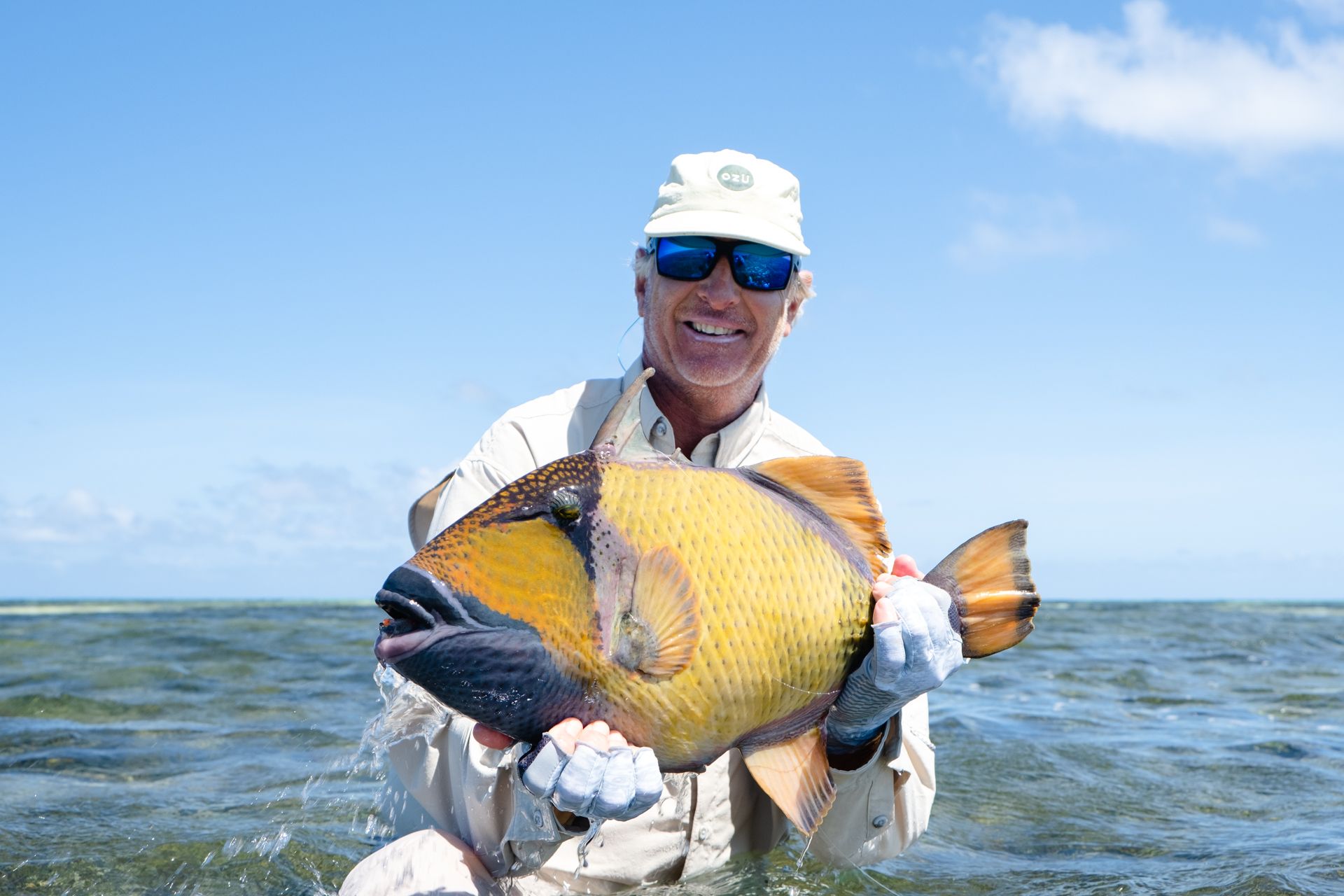 Angler happy with trigger caught on a fly
Angler happy with trigger caught on a fly
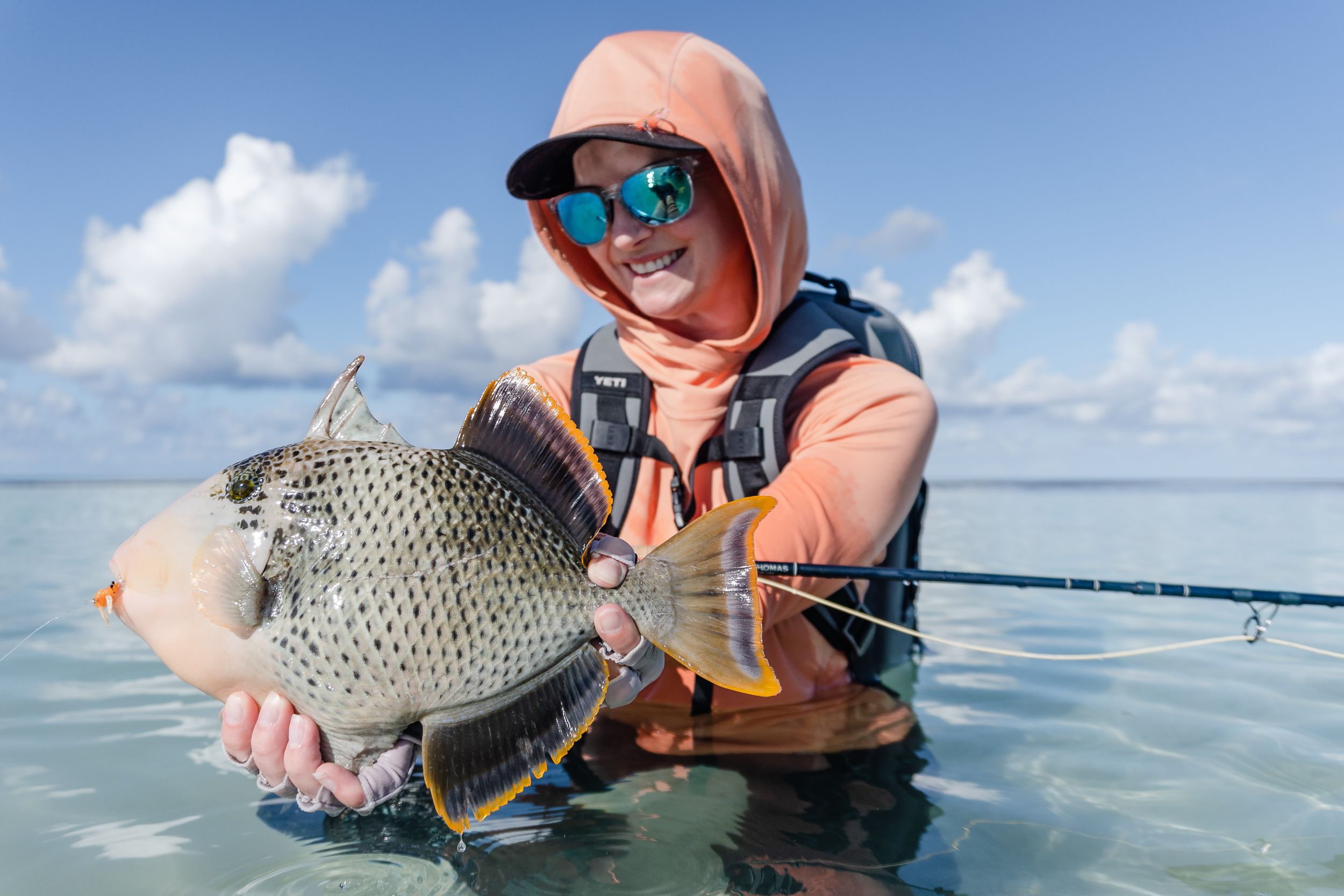 Angler happy with trigger caught on a fly
Angler happy with trigger caught on a fly
Triggerfish: triggerfish are bottom-dwelling fish that are found in the waters of the Seychelles. They are known for their strong fighting ability and their tendency to take a fly deep.
Discover more about triggerfish here
Mahi mahi: Mahi mahi are also known as dorado and are found in the open waters of the Seychelles. They are known for their speed, endurance, and acrobatic jumps, and can provide an exciting challenge for fly anglers.
Snapper: snapper are a common species found in the waters of the Seychelles and can be targeted in deeper waters and around structures. They are known for their hard, powerful runs and their tendency to take a fly deep.
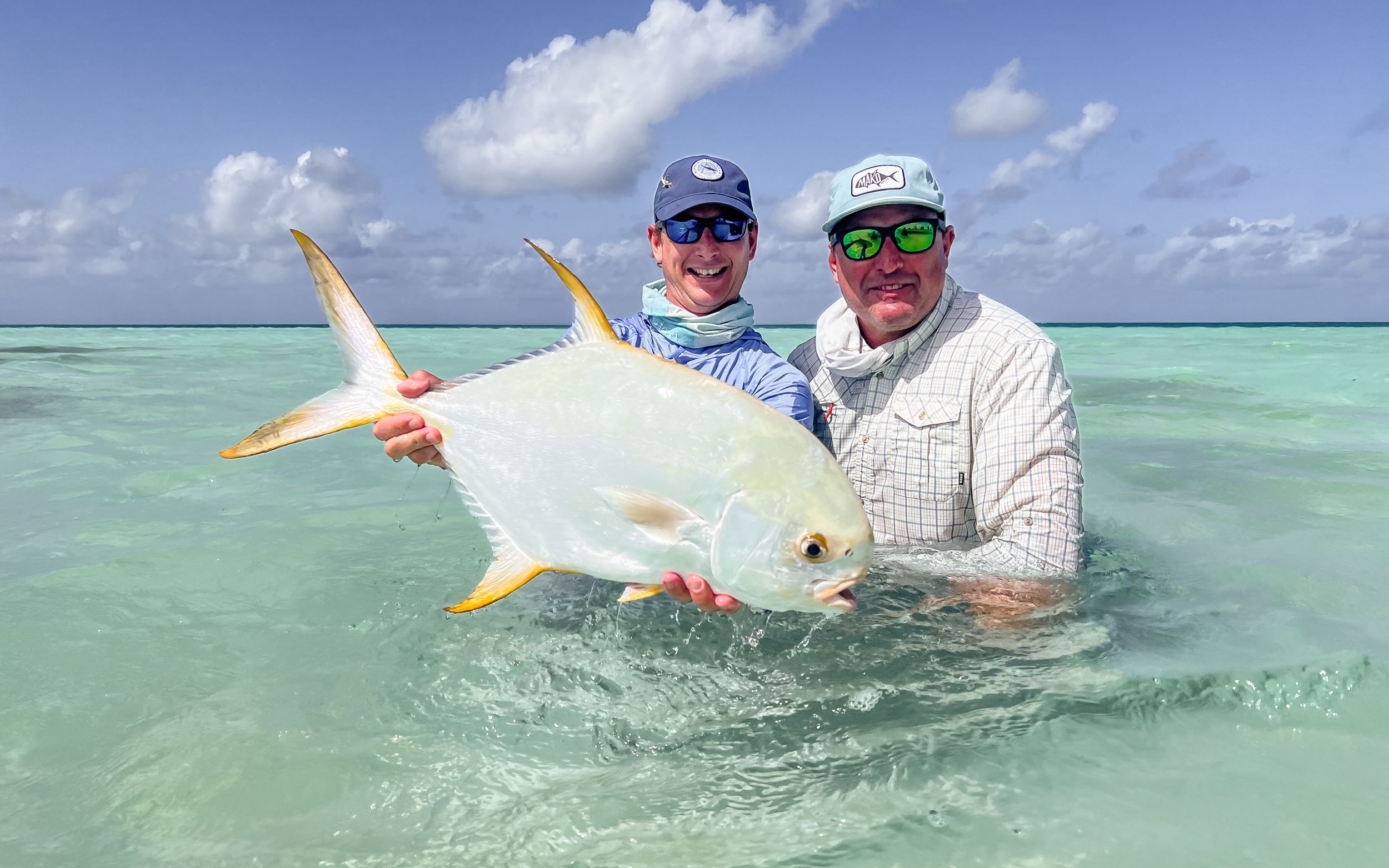 Angler with an Indo-Pacific permit caught on a fly
Angler with an Indo-Pacific permit caught on a fly
 Angler with an Indo-Pacific permit caught on a fly
Angler with an Indo-Pacific permit caught on a fly
Permit: Indo-pacific permits are highly prized by fly anglers for their strong fighting ability and challenging behaviour. They are found in shallow waters and around structures.
Discover more about indo-pacific-permit here
Discover our island fly fishing destinations
Alphonse Fishing Company offers world-class saltwater fly-fishing experiences in various locations around the Seychelles Outer Islands. AFC destinations include the following:
- Alphonse Island: One of the most famous saltwater fly fishing destinations in the Indian Ocean, this fishery boasts the highest bonefish populations in the world. It offers ten thousand acres of white sand flats with easy wading and world-class fly fishing. The fishing season runs all year round, with certain times being more suited to experienced anglers.
- Cosmoledo Atoll: Known as the GT capital of the world, Cosmoledo Atoll has the healthiest population of giant trevally on the planet, as well as a healthy population of bonefish, milkfish, Indo-Pacific permit, and triggerfish. Offshore fly fishing opportunities for sailfish, wahoo, and yellowfin tuna are also available.
- Astove Atoll: The fishing season on Astove Atoll traditionally runs from November to late April and is limited to a maximum of four anglers at any given time to keep the conservation of the atoll top of mind. The lagoon is a sanctuary for both juvenile and trophy-sized fish that feed on the shallow white sand flats.
- Farquhar Atoll: Home of the bumphead parrotfish and bird-eating GTs, Farquhar Atoll is the most southerly atoll in the Seychelles islands. The large ear-shaped lagoon provides easy skiff access to the countless flats, channels, and surf zones that makes Farquhar Atoll such an amazing fly fishing destination.
- Providence Atoll: This remote atoll has a total area, including the large lagoon, of 345 km², which is 55 km north to south and 14 km east to west. The atoll comprises of two Islands, Providence North and Cerf Island and an enormous shallow lagoon system with vast flats and sand banks that link to the ocean through countless feeder channels.
- The Amirante Islands: A collection of islands that are largely unpopulated and are one of the most desirable fishing destinations for both fly fishing for Indo-Pacific permits and offshore fishing. They are made up of Étoile, D’Arros, Marie Louise, Desnoeufs, Boudeuse, African Banks, Rémire Reef, St. Joseph’s Atoll, and Poivre Atoll.
Seychelles has long enjoyed a reputation for being among the best saltwater fly-fishing grounds in the world, offering a diverse range of trophy fish species in ideal fly-fishing ecosystems.
If you’re interested in experiencing some of the world’s best saltwater fly fishing, Alphonse Fishing Company’s destinations in the Seychelles offer a remarkable experience.
More about our packages here
Join our fishing community
Join our community to get regular updates about our fishing adventures, guide updates and special offers.
